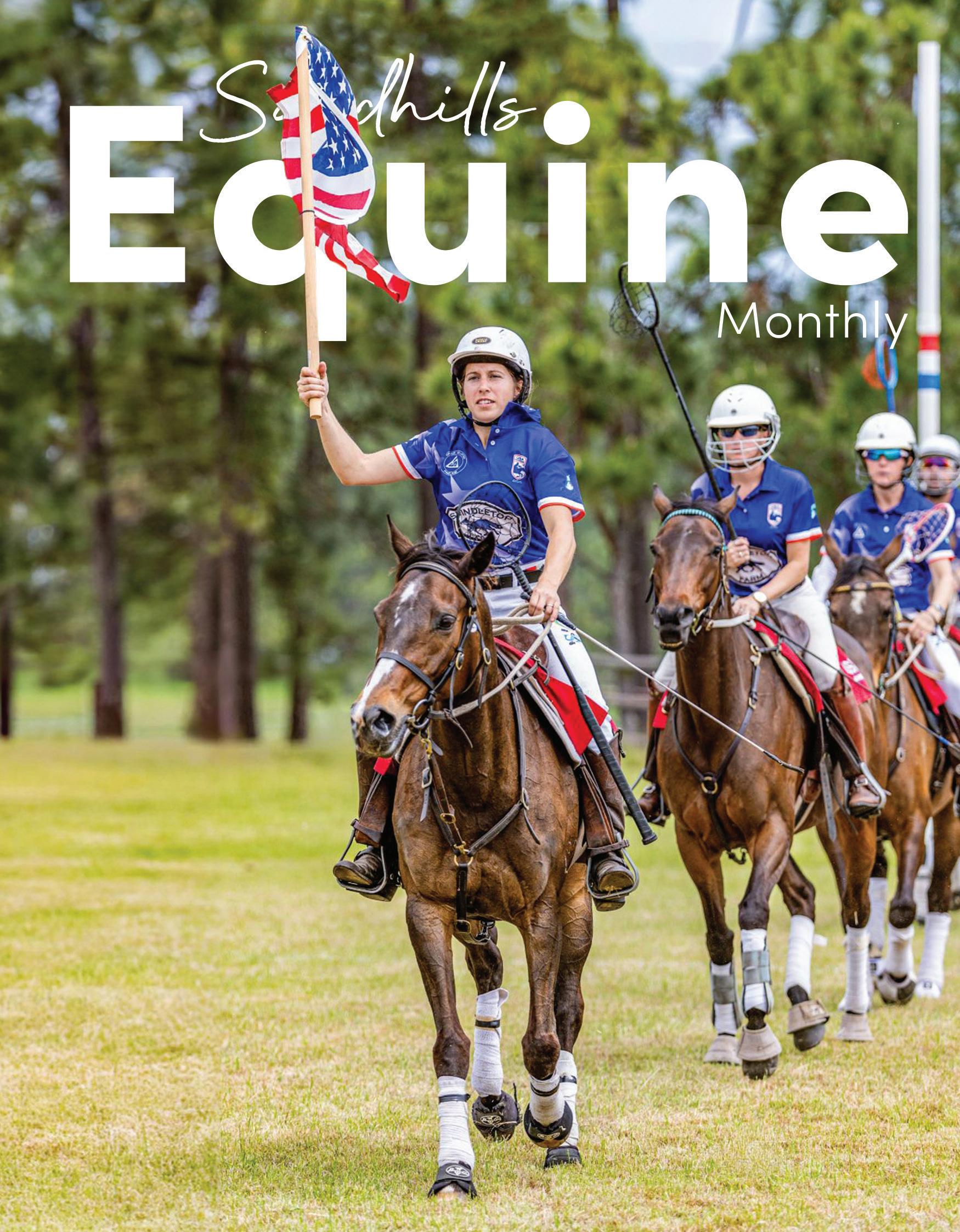
South African Goals:
Carolina Polocrosse Players
Bound for World Cup Tournament Celebrating a Trailblazer Kay Whitlock
The Mane Stream
Equine Inspired Businesses



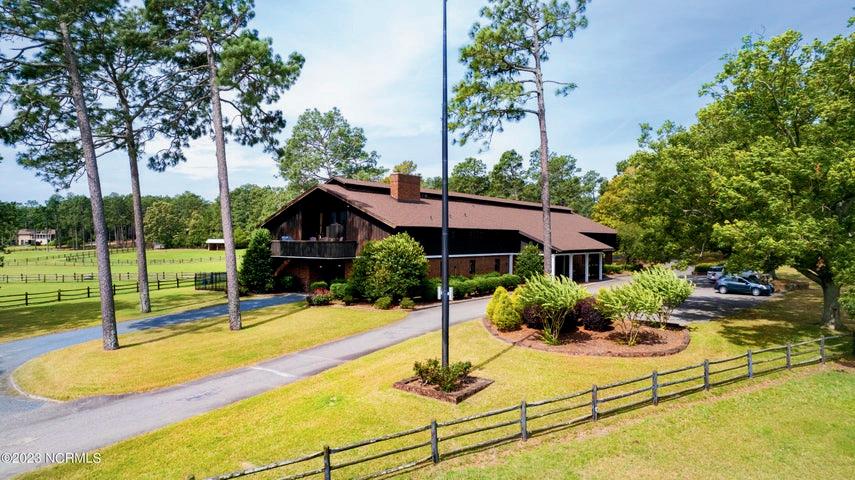
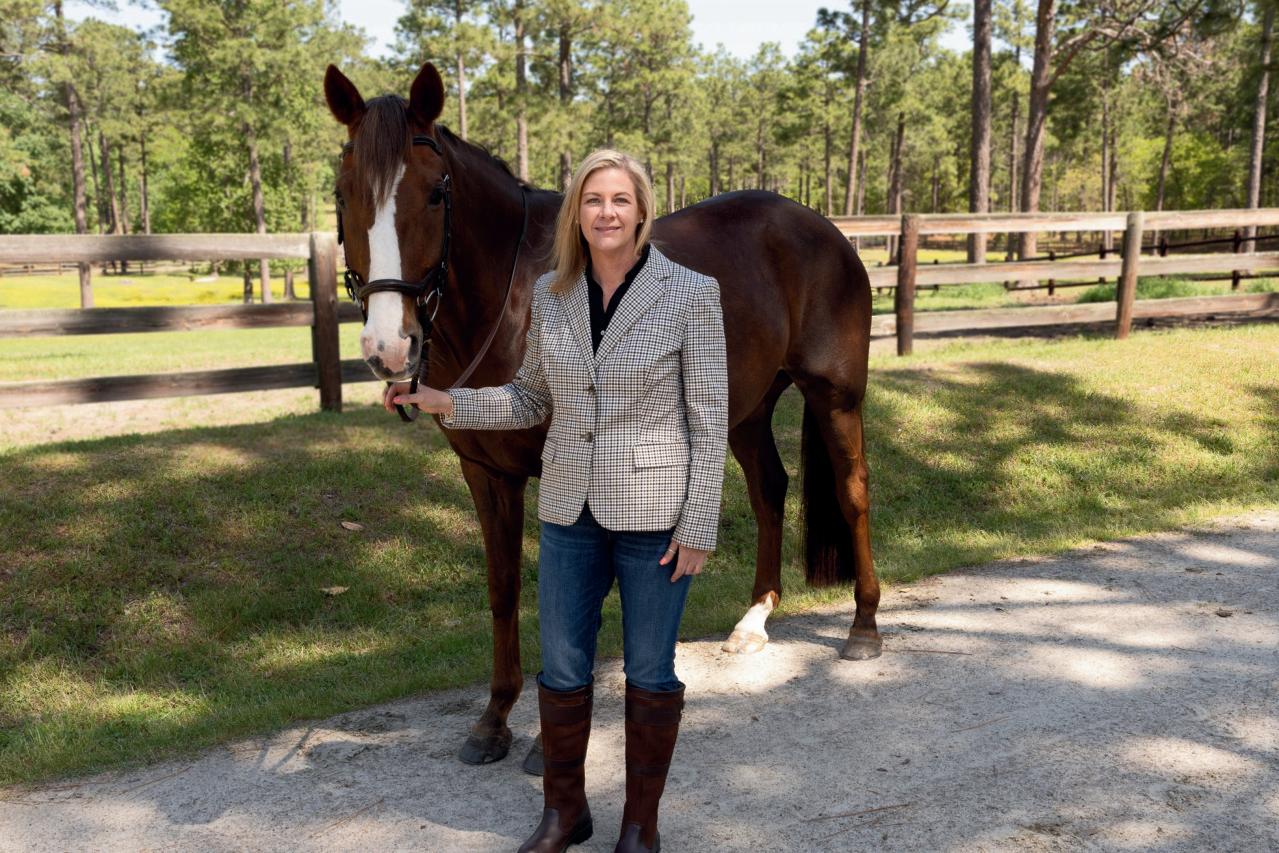
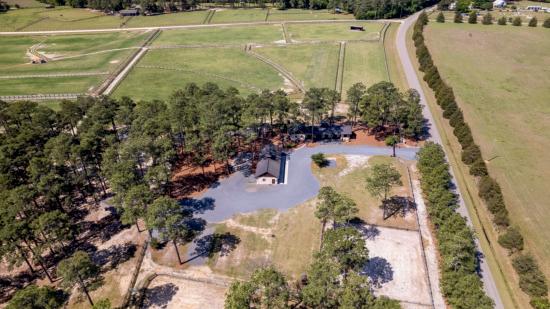
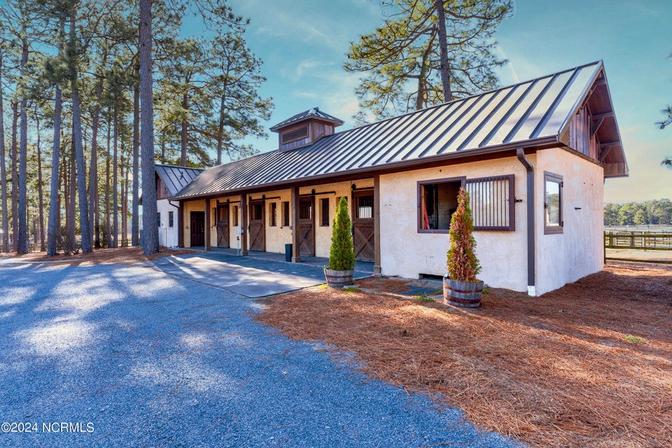
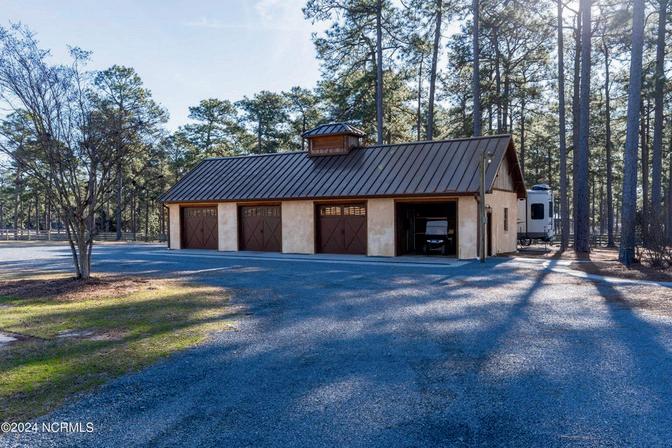

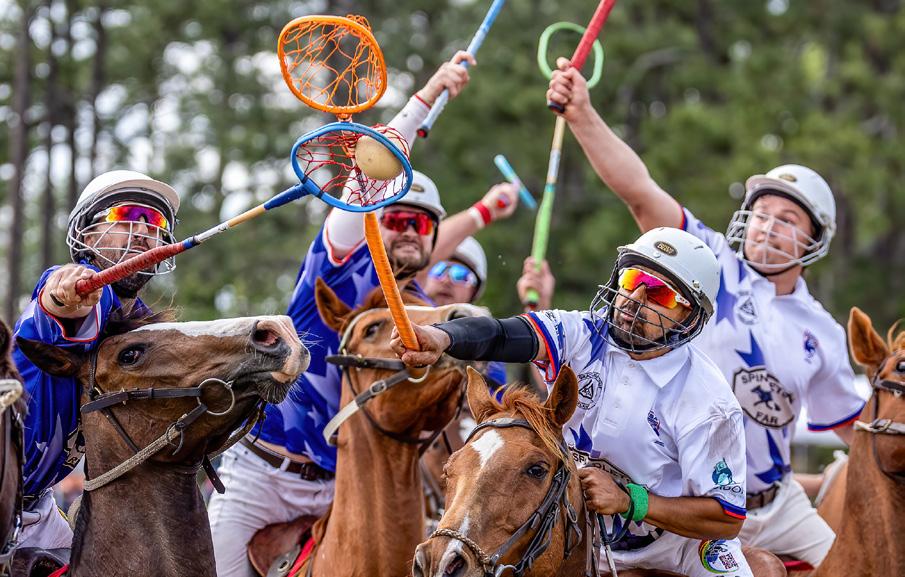
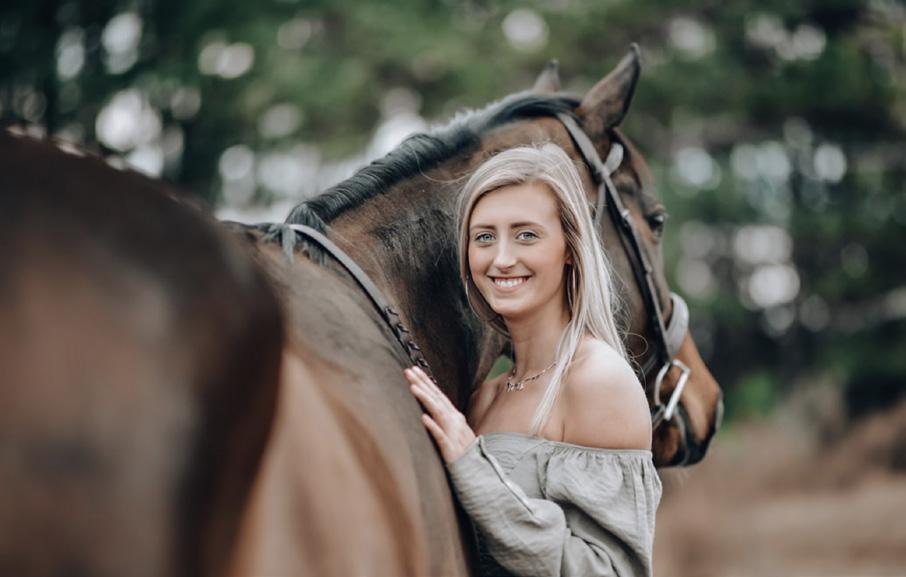
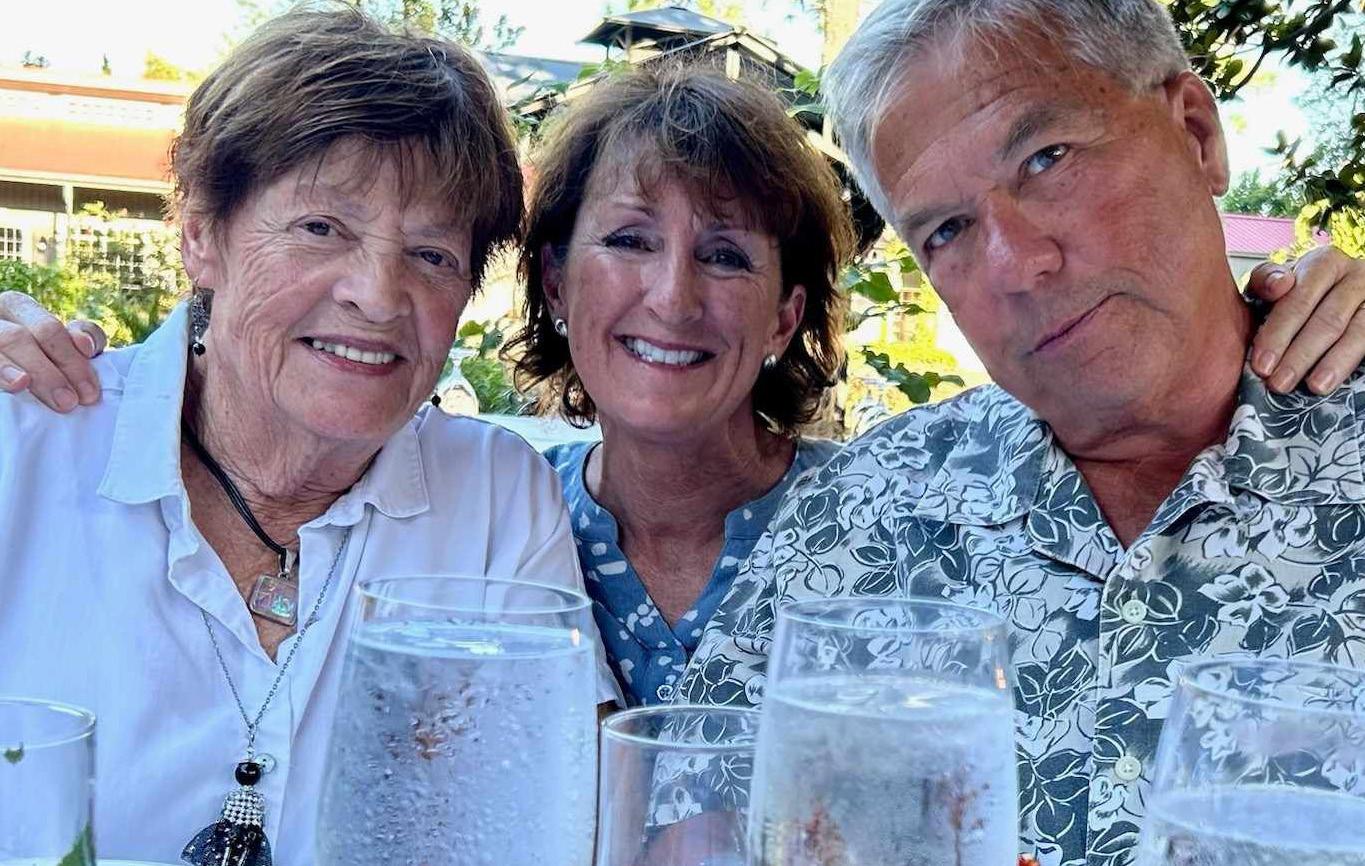
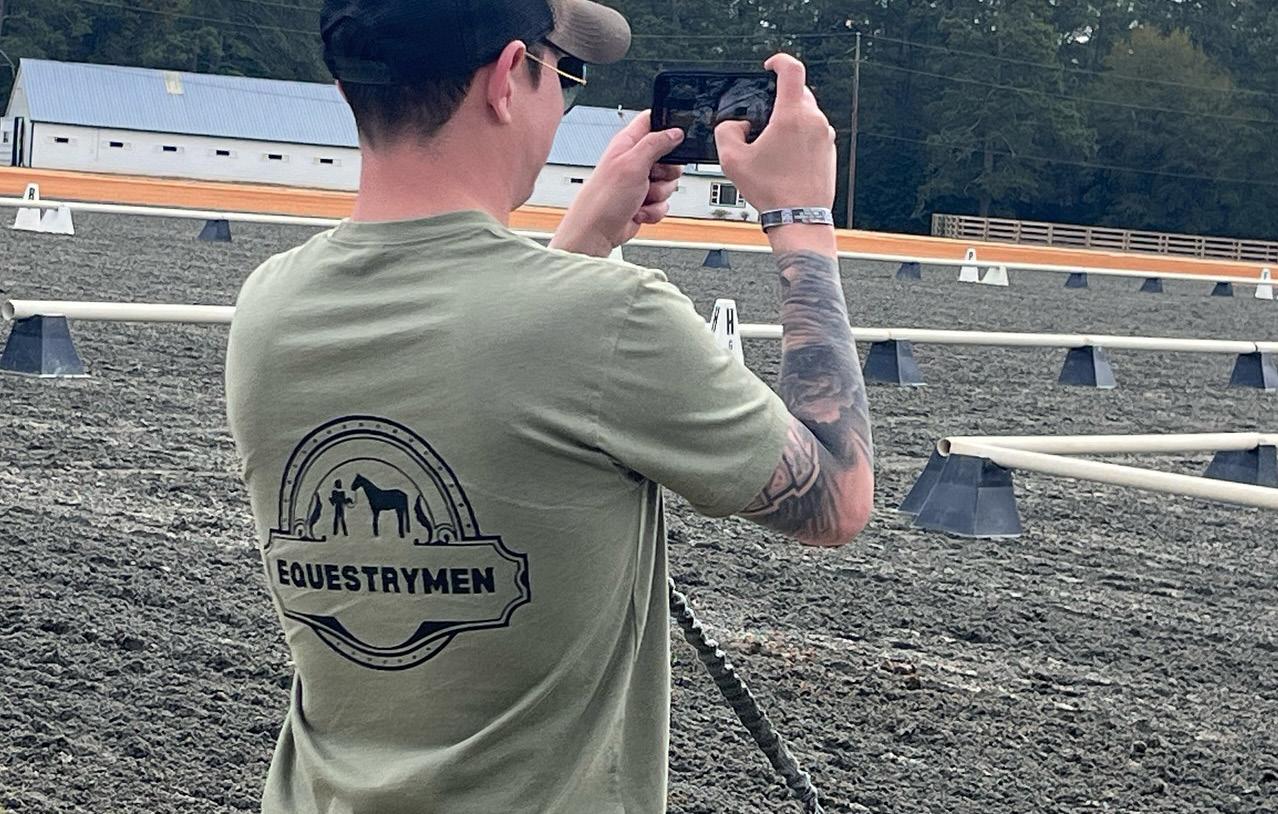


South African Goals:
Carolina Polocrosse Players
Bound for World Cup Tournament Celebrating a Trailblazer Kay Whitlock
The Mane Stream
Equine Inspired Businesses













Publisher BIC R Media, LLC
Editor:
Cassidy Oeltjen
Layout and Design
Ines Ritter
Contributors
Ray Owen
Mary Kate Murphy
Cassidy Oeltjen
Christina Boucher Reynolds
Moore County Hist. Assoc.
Lisa Miyamoto
Jason Jackson
Candy Allen
Eliza Sydnor Romm
Ines Ritter
Advertising & Subscriptions info@sandhillseqm.com
General Inquiries info@sandhillseqm.com
Cover
Players of the NC Polocrosse Team
Photo: Jason Jackson
Follow us on www.sandhillseqm.com
Sandhills Equine Monthly owned by BIC R Media LLC 360 Fairway Dr Southern Pines, NC 28387
No part of this publication may be reproduced without the expressed written consent of the Publisher
The Sandhills Equine Monthly Magazine and BIC R Media LLC do not neccessassrily endorse the views of their contributors or advertisers.
Welcome back!
Things may look a little different, but we dive in this month with the same great tales from around the Sandhills and beyond!
This month, these stories take us down the path of equine industry professionals whose careers don't involve hours spent in an arena. Our mind often goes to trainers or instructors, but there are so many more roles that allow people to wrap their lives around four-legged equids without wrapping their legs around one.
From Lauren Newland's entrepreneurial growth, to Christina Boucher Reynolds' path to becoming a equine nutritionist and Kay Whitlock's role in establishing dressage in the Sandhills, we look at how these women have made their mark in the equestrian world. And some people bring their equestrian mark to the world beyond our horse community, influencing mainstream businesses with equid flare as we see in The Mane Stream.
Our "three questions" gets a little personal for me, bringing in my husband who is making the most of his 'forced' role in this wild world by creating a support group for all those others who didn't see being a horse dad in their future plans.
As always, we are so honored to be in this position, bringing you information and entertainment in the form of Sandhills Equine Magazine. For more in depth stories and online exclusives, be sure to visit www.sandhillseqm.com and follow along on our Facebook page.
Cheers!
Cassidy Oeltjen Editor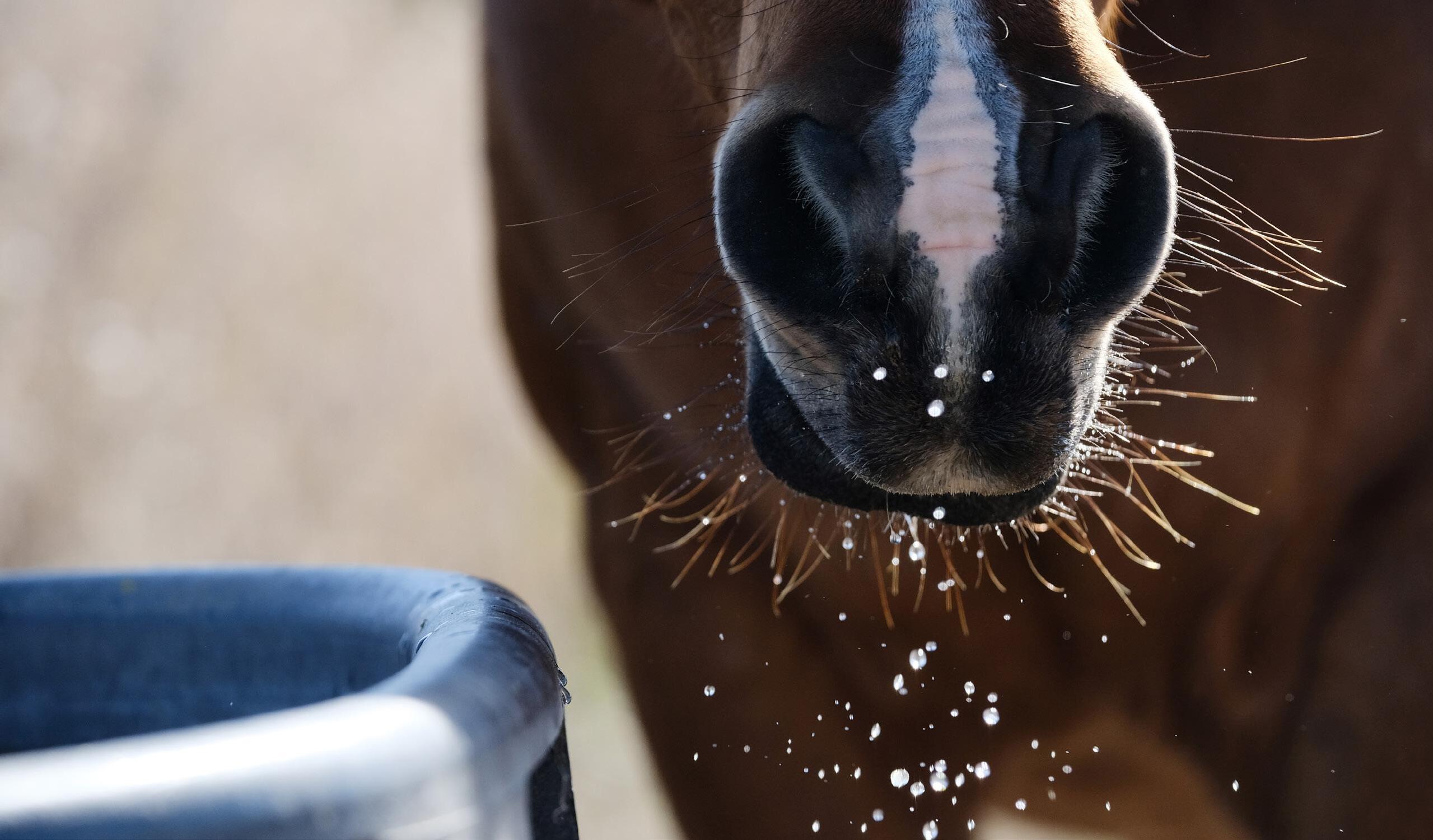
With the oncoming heat and humidity paired with show season and trail riding in full swing, it’s a good time to re-evaluate whether your horse’s hydration is where it needs to be.
The thin line between moderately dehydrated but fit to continue and dehydration that requires IV fluid replacement is just 2-3 gallons of unreplaced fluids.
Five percent dehydrated (or about 6.25 gallons unreplaced fluid loss) is the point where most endurance horses finish and are judged by a team of vets

as “fit to continue”, which means the pair has completed the ride successfully (in endurance you don’t just get to cross the finish line, you must also be judged as “fit to continue” as if you still had another 15 mile loop to complete). At 8% fluid loss (or about 9 gal unreplaced fluid), the horse is in the treatment box being given IV fluids. At 12% dehydration, the horse is likely in organ failure and at risk of dying. The difference between tolerable fluid loss and organ failure is a mere 8 gallons.
There are about 80 gallons of fluid in the horse and about 2/3 of it is not easily accessible because it is inside of cells. Twenty-six gallons are in the
extracellular space (i.e. not inside of cells) like blood, saliva, urine and fluids in the gut. A loss of 2-4 gallons of fluids equals an 8-15% loss in the circulating fluids until the body can share fluid from inside the cells or they are replenished by drinking or administering IV fluids.
At 2% dehydration, which the horse is likely to be at before even starting exercise in the summer or after you trailer to an event, the body starts to conserve fluids and the first place it starts is saliva production. You can see this when checking the gums, they will have a “tacky” feeling. Decreased saliva production can increase the chance of esophageal obstruction, also known as
Christina is a graduate of NCSU’s College of Agriculture and Life Sciences with a degree in Animal Science and concentration in nutrition. She has a professional animal scientist certification in equine, beef cattle and nutrient management from The American Registry of Professional Animal Scientists. Christina has worked in the nutrition and vet med industries in several capacities and currently works for Triple Crown helping horse owners navigate feeding and managing their horses.
‘choke’, especially for horses eating dry hay. Feeding a wet mash, soaked forage or regular grass can help reduce the risk of developing choke.
For every hour of trailer transport under ideal ambient conditions, in a good trailer with a considerate driver (aka, not adding stress), a horse will become 1% dehydrated for every ninety minutes of travel. We rarely have ideal weather conditions in North Carolina! Horses arrive at their show or trail ride already behind the eight ball in terms of hydration.
For horses traveling a long way, horses will easily be at the 5% dehydration level where they are feeling the effects of dehydration. They are unlikely to replace their fluid levels by themselves overnight and are likely to begin the competition with a level of dehydration that will negatively affect their performance.
Giving the horse extra time to recover after trailering is a good way to increase their ability to perform. In humans, 3% dehydration means a 10% decrease in muscle strength (think driving up a hill or jumping) and 8% decrease in muscle speed (think ability to recover after a stumble or make a quick turn in the ring). We don’t have research numbers on that in horses, but we can assume it will be similar.
The first bodily fluid to be affected by fluid loss during exercise is plasma - the watery portion of the blood. In extreme conditions, horses can lose four gallons of fluids per hour in sweat. As the watery portion decreases, the blood becomes thicker and harder to transport around the body This is where you often see a “hanging heart rate” that doesn’t want to drop below 60 or so and is a useful indicator that the horse is being adversely affected by the level of dehydration.
To get proficient at checking heart rate and using it to understand both
cardiovascular fitness and dehydration effects, you can use either your hand or an inexpensive stethoscope. Place it behind the left point of elbow near the girth and listed for the ”lub-dub”, and count each paired “lub-dub” as one heartbeat. You can use your watch or the timer on your phone to count the beats for one minute. Find out your horse’s resting heart rate first and check it a couple times over a couple of weeks to establish what “normal” is for your individual horse. This is helpful knowledge for your vet too, when you call in an emergency. Temperature, heart rate and respiratory rate give the vet a ton of information as they decide how much of an emergency they may have on their hands.
do this even while still exercising, which can be a problem as sweating is a major way the body can decrease thermal load and avoid hyperthermia. Clipping horses, keeping heavy manes braided and off their necks, and sponging down regularly with water can help minimize the effects of the decreased sweating.
Unfortunately for us, horses’ thirst mechanism is not well designed for what we ask them to do. In humans, sweat composition is saltier than our blood, so we have a cue to drink (thirst) relatively early in the dehydration process compared to horses whose sweat is less salty than their blood. It takes a while for the blood sodium level to increase enough to trip their thirst cue.

Research in endurance horses shows they drink 10% more water if their eyes never go below the rim of their container.
Once you know the horse’s resting heart rate, check it after your rides and see what the number is. You can check it every 5-10 minutes post-ride to evaluate your horse’s ability to recover. If you have a fit horse, they will likely come in from moderate exercise around 75 bpm and fairly quickly drop below 60 and then to their resting heart rate. An unfit horse will be slow to drop below that 60 mark but will progress down gradually, and a dehydrated horse will drop a little then remain the same for a while.
After decreasing saliva production to conserve fluids, the next thing a horse will do is decrease sweating. They will
Horses also rely more on their blood pressure dropping due to dehydration to signal thirst than the blood-sodium level alert that humans use. This is a slower process than the sodium trigger, and often means horses aren’t interested in drinking until they are much more dehydrated.
It’s important to note that horses cannot be encouraged to drink by squirting water in their mouth. In fact, this can prematurely shut off their thirst drive by tricking the brain into thinking the horse has drunk water thanks to a reflex that shuts down thirst when it senses water in the mouth. Good for helping
prey animals not get eaten at the water hole, bad for dehydrated horses in the sweaty Southeast who are going to compete after a trailer ride.
So how can we help horses stay hydrated?
Establishing good hydration leading up to an event is an excellent way to start the process with a good hydration status. Make sure clean water is readily available 24/7 leading to the event. Research in endurance horses shows they drink 10% more water if their eyes never go below the rim of their container. University research shows horses drink more from turquoise buckets. Research at New Bolton showed horses prefer to drink water around 45 degrees F regardless of outside temperature, but will drink more water at 65 degrees F if there is no cold water option.
Offering “treat water” may entice horses to drink more and may help picky horses. You can add a couple
handfuls of rice bran and/or senior feed to the bottom of a bucket before filling and offer it before travel and at stopping points along the way. Dr Garlinghouse’s tip is to make a soupy mash of your horse’s regular feed plus beet pulp or hay cubes and hang it in the trailer, adding a piece of 2x4 floating on the top as a baffle to keep it from sloshing out.
Increasing the amount of sodium in the horse’s diet leading up to the event can help them drink more; Dr Vandergrift recommended a couple of tablespoons of baking soda split between their meals in the days leading up to a trailer ride or event. The baking soda provides just sodium which kicks on the thirst drive, whereas salt provides both sodium (thirst drive) but also chloride (signal to pee out extra fluid).
Once your horse is exercising and sweating, using a suitable commercially available electrolyte blend will provide the electrolytes your horse is losing through sweat. I personally like the



Apple A Day product which provides a high level of the most needed electrolytes, plus a higher level of calcium that heavier muscled horses need, and without added sugar. My preferred paste electrolyte is EnduroMax which has a similar high level of needed electrolytes and no extra sugar but also has a gastric buffer, which I recommend anytime you’re feeding electrolytes by oral syringe.
• horses become dehydrated quickly during hot weather
• trailer rides contribute a significant amount of dehydration before the horse even starts work
• re-hydration takes time and some planning
• horse’s thirst reflexes often don’t match their state of dehydration
• dehydration has a marked effect on performance.
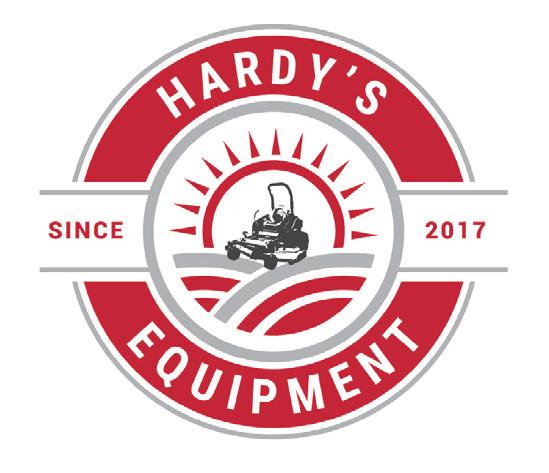



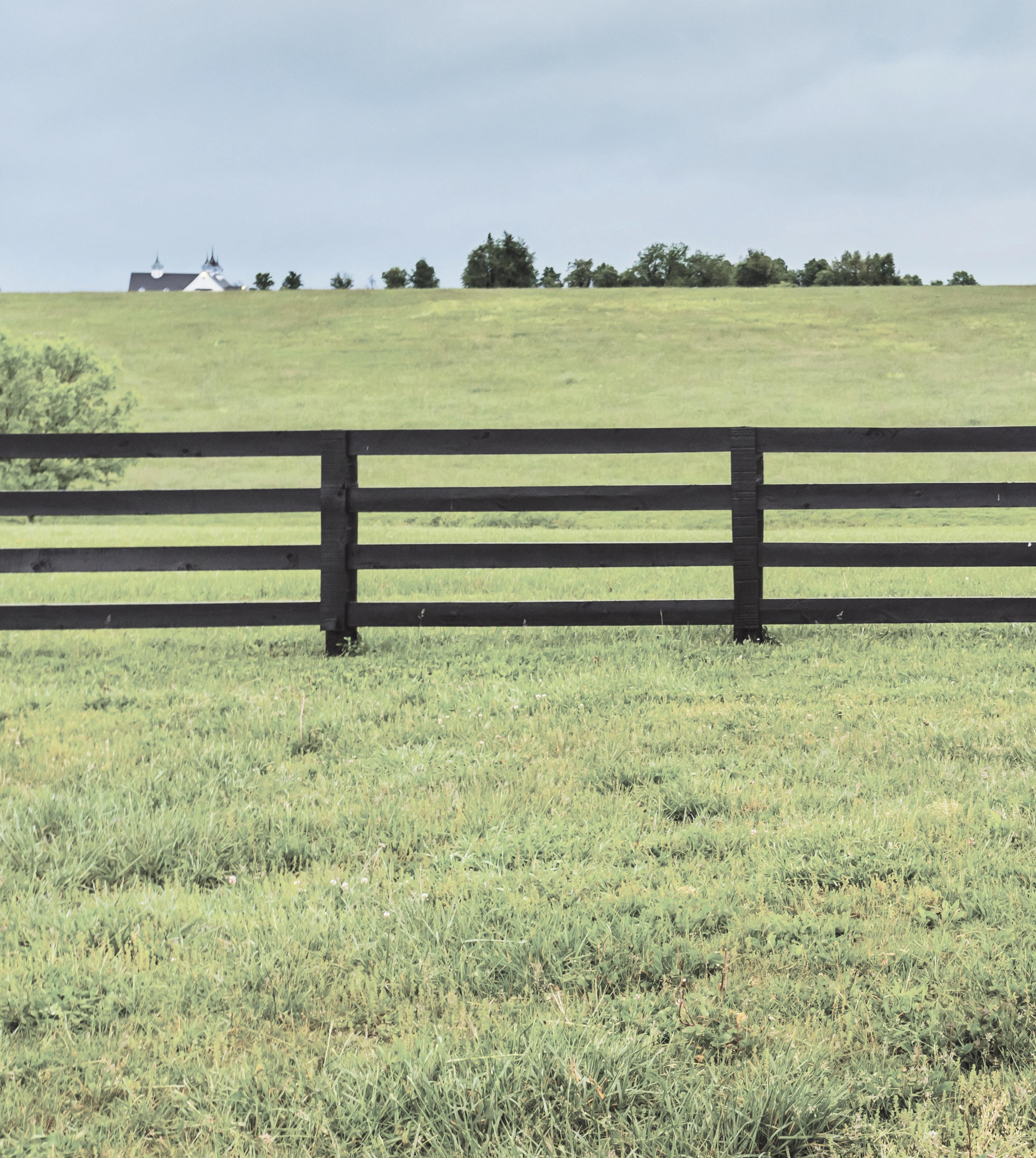







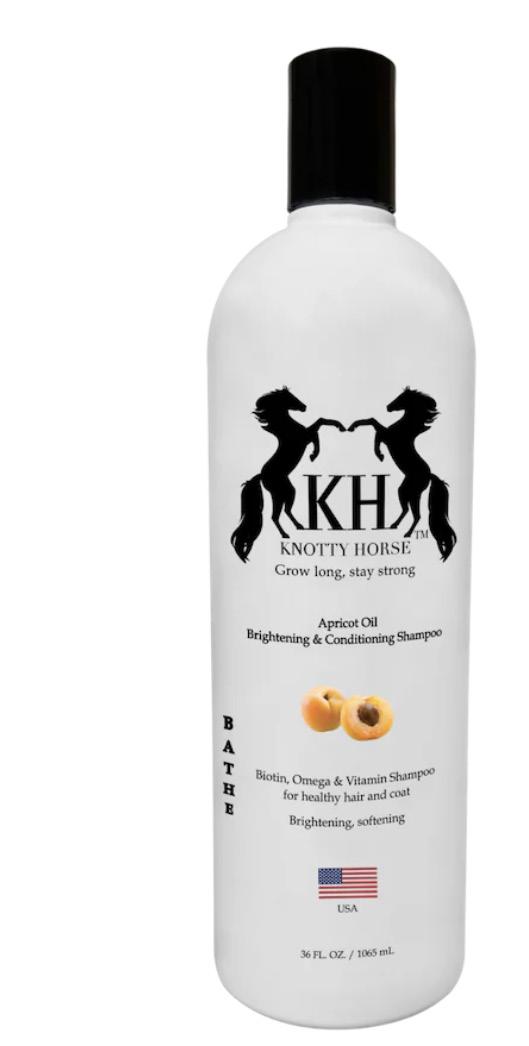
The Knotty Horse Apricot Oil Brightening Shampoo effectively brightens and removes tough stains without stripping essential lipids from the coat and hair. Gentle enough for sensitive skin types, this shampoo treatment enhances ALL coat colors by effectively lifting dulling dirt and grime. Apricot Oil, Omegas, Aloe Vera and Biotin for added nourishment and hydration. Suitable for sensitive skin. Paraben-free, Phthalate-free, Vegan and Cruelty-free Get it at www.knottyhorseproducts.com
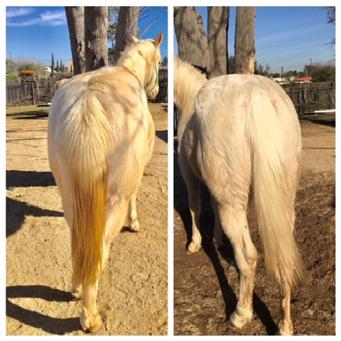

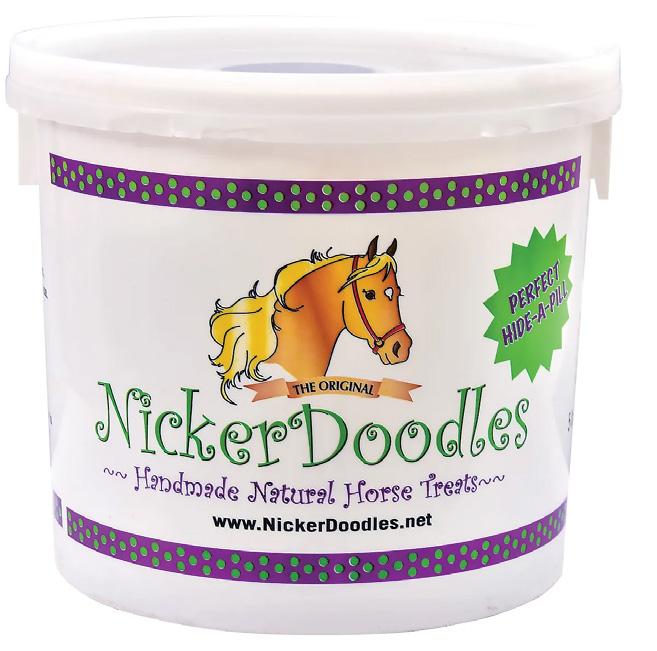

Just the treat you’ll need! (Just ask your horse)

NickerDoodles, renowned for its easily digestible soft treats, contains a blend of ingredients, including oats, wheat bran, barley, molasses product, and corn. These yummy treats are freshly baked in the Carolinas under the stewardship of Charles and Laurie Day, the proprietors of Daydream Farm in Pittsboro, North Carolina.
Many horse owners, already well-acquainted with NickerDoodles, agree that they have yet to meet a horse who did not love them from the first bite... and we think yours will, too!


Pink Mash is an innovative soaked fiber support for the horse’s digestive tract. Horses and ponies can have their natural biorhythmic patterns disturbed for various reasons. Pink Mash was created to restore the natural, healthy functioning of the horse’s gut despite the environmental challenges that can often occur.
• Powerful Beetroot Antioxidants.
• Provides a highly valuable source of daily hydration.
• Probiotics that help leverage the horses ability to generate energy (VFA) from hind gut fermentation of fibre through enhanced microbial health.
• Extremely cost effective and economical.

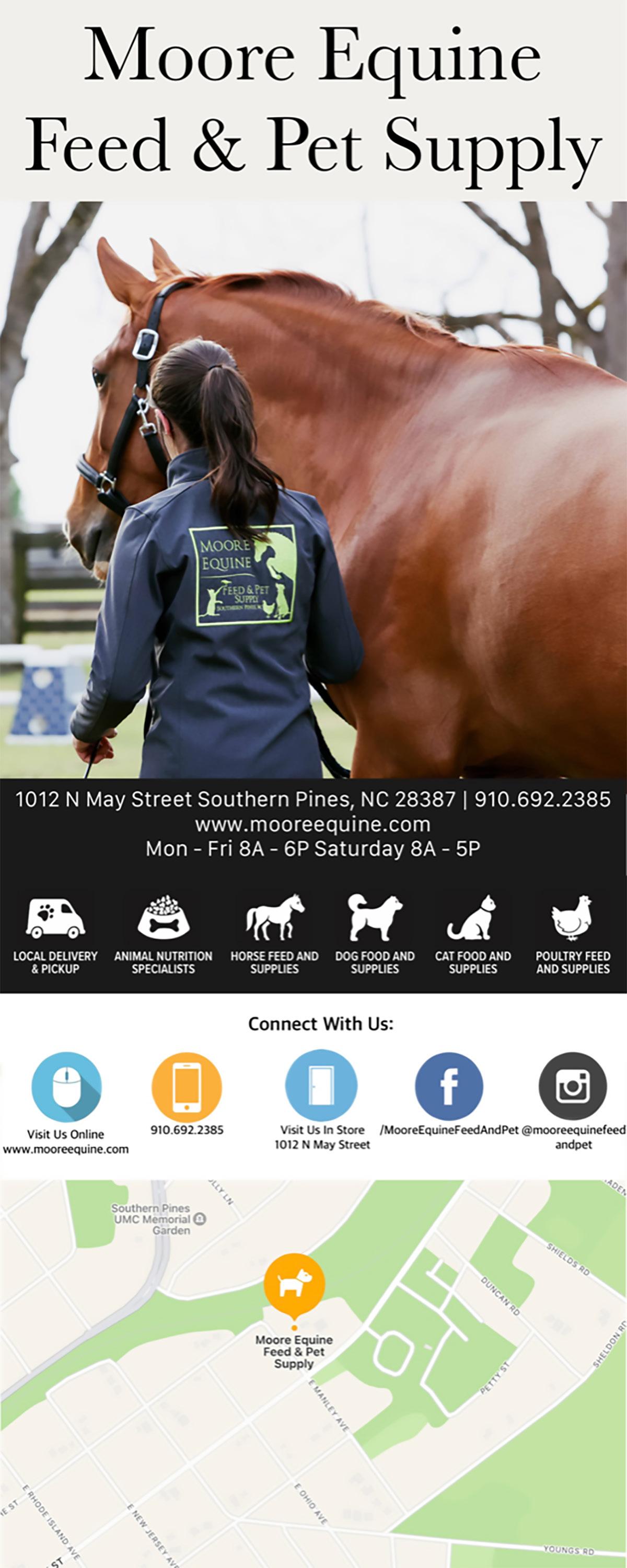

Here’s an exact recipe for keeping your horse sound…
Ok, not really, there's no such thing. But here's my best attempt. I have some students shopping for young horses, and I've sold some super nice horses recently, and everyone is trying to figure out the best crystal ball that will tell them if their future horse will stay sound in the long term. Spoiler alertno one (not even the fanciest vet) can tell you that. Horses are horses, and they do incredibly dumb things to hurt themselves all the time. But here's what I advise my students:

1. Turn your horse out. Motion is lotion, and horses who move around as much as possible, on varied terrain, are going to be stronger and have more resilience than horses bubble wrapped and kept inside. And yes, I know it’s scary to think of them possibly getting hurt in turnout or with buddies. But I promise you they can hurt themselves in other ways because you DO NOT turn them out or allow them normal socializing. (Think ulcers, colic, behavior problems, and then generally injuring themselves when they finally get out.)
2. Buy the best conformation you can. The horse doesn't need to win all the breed shows, but certain conformation
Eliza Sydnor Romm,
problems are a deal breaker for melong sloping pasterns, super straight hocks and stifles, super long backs, crooked legs. You're just asking for problems down the road. No horse is perfect, and even those with gorgeous conformation can go lame, but set yourself up for success. Good basic conformation is MORE important than fancy movement.
3. Buy a horse with good feet. "No hoof no horse" is not just some old time adage. If you are dealing with a horse with super thin soles or walls, chronically slung under heels, negative palmar angles, or a high/low problem, you will be dealing with lameness more often.
Extension Agent, Agriculture - Livestock, Field Crops, Moore County. Tom comes from a background in small ruminants and beef cattle focusing on pasture management and sustainability. He is also an avid horseman, specializing in moving livestock on horseback and practices roping .
Eliza Sydnor Romm is a classically trained dressage rider, trainer and instructor. Eliza is a successful competitor and a sought-after trainer. In 2007 Eliza made history by becoming the youngest person in the United States to receive her USDF Training-Fourth Level Instructor Certification. Eliza is the daughter of Cindy Sydnor, a well respected dressage trainer from North Carolina who was long listed for the USET from 1976 – 1979.
4. Hire a good farrier. To go along with the last point, your horse's feet need to be in the best shape possible. I'm not getting into it with the barefoot vs. corrective shoeing people. I'll just say try to find the best farrier you can. Ask the vets, ask people who have horses with beautiful feet at the shows, interview prospective farriers, whatever you need to do. And be good to that farrier!!
5. Ride on decent footing. Notice I didn't say expensive footing! Super deep, super hard, slippery or uneven are no nos. A nicely mowed field that's decently flat is better than a pretty looking arena that is way too deep.
6. Give your horse good nutrition. Especially with young, growing horses - keeping them healthy but NOT fat is important. Work with your vet to design a program that gives your horse enough vitamins, minerals, protein and fat. Making a horse super fat and shiny might look nice for pictures, but that is not a kind thing to do for their long term health. On the other hand, not feeding a horse enough can have seriously negative consequences for their development as well.
7. Get tack that fits and then focus on something else. Yes, you need a saddle, bridle and bit that fit your horse. But you probably don't need to spend half your life savings on it, and have it adjusted 4 times a year by a wizard from Europe. Make sure your saddle is balanced, doesn't pinch, and isn't making your horse's back sore (or you sore) and then move on. All the fancy pads, newest ergonomic designs, latest in bit technology, etc. are mostly just marketing.
8. Stick with a regular training program. Horses who sit around doing nothing are likely to get stiff, overweight and lack muscle. Horses who are overworked are likely to damage joints and soft tissue. Three to four days a
week is a great goal to aim for. More is not always better, and if you have to give your horse an extended period off, please be mindful as you bring them back into fitness and don't push it just so you can get to a show.
9. Come up with a long term plan with your vet. Most vets would love to see your horse for a once a year "wellness exam." This does not need to be terribly expensive, but just an overall soundness check where the two of you are able to plan out the best course of action for your horse. Depending on age and level of work, this could include supplements, injections, body work, etc. But allow your vet to have a baseline and get to know your horse BEFORE there is a problem!
These are not necessarily in order of importance. What I did NOT include is x-raying every joint in the body, all manner of drugs, supplements, fancy equipment, bloodlines, etc. I'm not putting any of that stuff down, but sticking to tried and true basics will do you better in the long term than jumping on the latest bandwagon.
Here’s hoping you all have sound and happy horses and many years of riding!! Cheers!

How Lauren Newland’s entrepreneurial spirit has let her do what she loves Cassidy Oeltjen
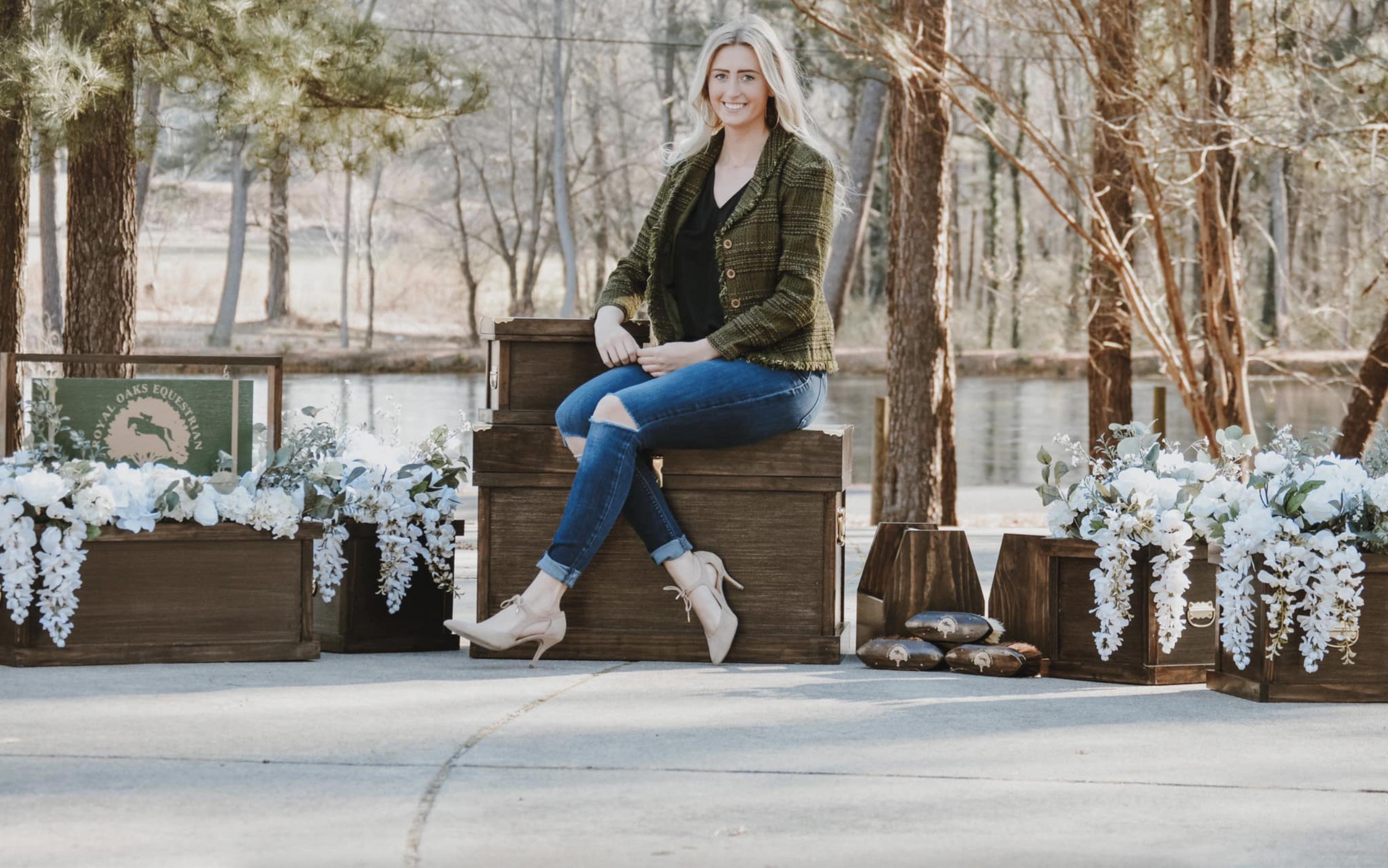
In horses, much like the rest of life, where there is a will, there is a way.
Growing up in a Garner, North Carolina subdivision, Lauren Newland wasn’t raised with a beautiful barn aisle, adorned with custom tack trunks and color coordinated drapes that she is now known for creating. Instead, her mom used their limited acreage to keep a few horses - a combination of semiferal ponies and older rescues.
“They were basically pasture ornaments with less-than-stellar manners, and very little experience off the property,” reflected Lauren. “Of course, the responsible thing to do was to take these basically feral beasts on long trail rides off site a few times a year, with little to no handling between. Little me, in my pink cowgirl boots, and pull-on breeches - yes it was a look - used to get stuck riding the worst one on these endeavors. While traumatizing in the
moment, the bucking, taking off, laying down in water, and being rubbed off on trees as a kid makes me laugh now.”
Once she was a “seasoned pro at trick riding”, Lauren was ready to move on to the slightly more tame world of horse showing. At just ten years old, a quick trip to the Raleigh Fairgrounds where the State 4H show was happening changed the course of Lauren’s equestrian career.
“I told my mom, ‘This. I want to do this,’” she said. “The next year as an eleven-year-old, I won the Short Stirrup eq on the flat at that same horse show. From then on, horses and showing have been my entire life.”
Like many young equestrians, Lauren could feel the restraint of the financial belt tightening around her competition dreams, but she wasn’t willing to let that hold her back. Her desire to save
money led to ways to make money in the horse show world, even as an eleven year old.
“I saved the $45 at 4H by braiding my own horse - taking 3 hours to do so,” she recalled. “Bless the other 4H moms that believed in me and my terrible braids at the time, for paying me to braid other horses in the barn, thus funding my 4H show career. Getting handed cash, or a check for the hard work you arranged and completed - it’s addicting. Thus my love for ‘wheeling and dealing’ for my horse dreams began.”
As Lauren’s riding career grew, so did her entrepreneurial spirit. Saving money by braiding her own horse expanded to making her own “A circuit approved” tack trunk.
“When I started showing more on the A show circuit, I decided the plastic trunks weren’t appropriate,” she remembered.
“Unfortunately, wooden trunks were expensive and incredibly heavy. Having absolutely zero experience with power tools, I decided to give building a trunk a shot. Borrowed tools, and a lot of mistakes later, I finally had my wooden trunk.”
Her original efforts weren’t intended to evolve into a business - but she did post pictures on her social media, leading to inquiries from other equestrians about having trunks made.
Her attention to detail and willingness to expand her skillset allowed her to start filling the needs of her fellow competitors. She became proficient with more and more tools, expanding her items from trunks and grooming boxes, to signage, drapes, show set ups, apparel and other personalized barn items.
Now known as Darlington South Woodworking, the business that Lauren created in 2017 (upon graduating high school) has matured along with the young entrepreneur. Having a working knowledge of the needs of a professional barn has allowed Lauren to better serve her clients. She keeps up with trends, and can provide insight into what might be the perfect addition for a show set up or even suggest new products for client gifts.
“My customers mainly come from North Carolina. Since moving to Norfolk, VA, I have expanded into a new market,” she said. “I have a bunch of returning customers as well as new ones. Although I do have an Etsy, I only offer a limited number of products to ship. Most of my business comes from word of mouth. I do very little advertising, since I typically am booked out pretty far. Through the years, I have reached customers all over the country and have steadily increased products and output.”
Running her own business had allowed Lauren to continue her competitive


will
office, tack room - whatever you


dreams and be directly involved with the equestrian world, with the freedom of picking her own travel schedule. She can plan ahead for opportunities such as traveling to compete in Florida for an extended amount of time by working long hours completing orders before leaving.
“I have the flexibility to work when I want, from where I want,” she reflected. “I typically show two weeks a month, so being able to pick up and travel is a dream. I love being hands on and assisting with the work that needs to be done at shows. If I still had a 9-5 job, getting time off for every show would be impossible. My time is better spent working for myself.”
allowed Lauren to expand her riding career from riding feral beasts in pink riding boots, to competing in some of the biggest shows east of the Mississippi.
“If an item gets left out of a wholesale shipment I received, or we have a surprisingly nice day outside, I can always pivot and change up my day,” she continued.

Just as a trainer or any equestrian career that wraps up hobby, freetime, friends, and business into one lifestyle, having a bit of balance and prioritizing some time away from the industry is important. For Lauren, that looks a lot like many 20-somethings with concerts, time with friends, and taking advantage of the little moments to clear her head, coming to work fresh and ready to create.
While being a business owner may seem like a fairytale filled with days lounging by the arena, watching beautiful horses and answering a few emails, it takes a certain kind of balance and willingness to be flexible. These attributes have
“My typical riding days, I wake up, knock out the list of things I planned for the day, and head to the post office on the way to the barn in the afternoons,” she explained. “I try to look at the forecast at the beginning of the week, making sure I plan out the best woodworking days versus inside days. There really isn’t a set routine, which makes this job fun.”
“During the summer months, taking my German Shepherd on a walk around the block is a lunch time must,” she concluded.
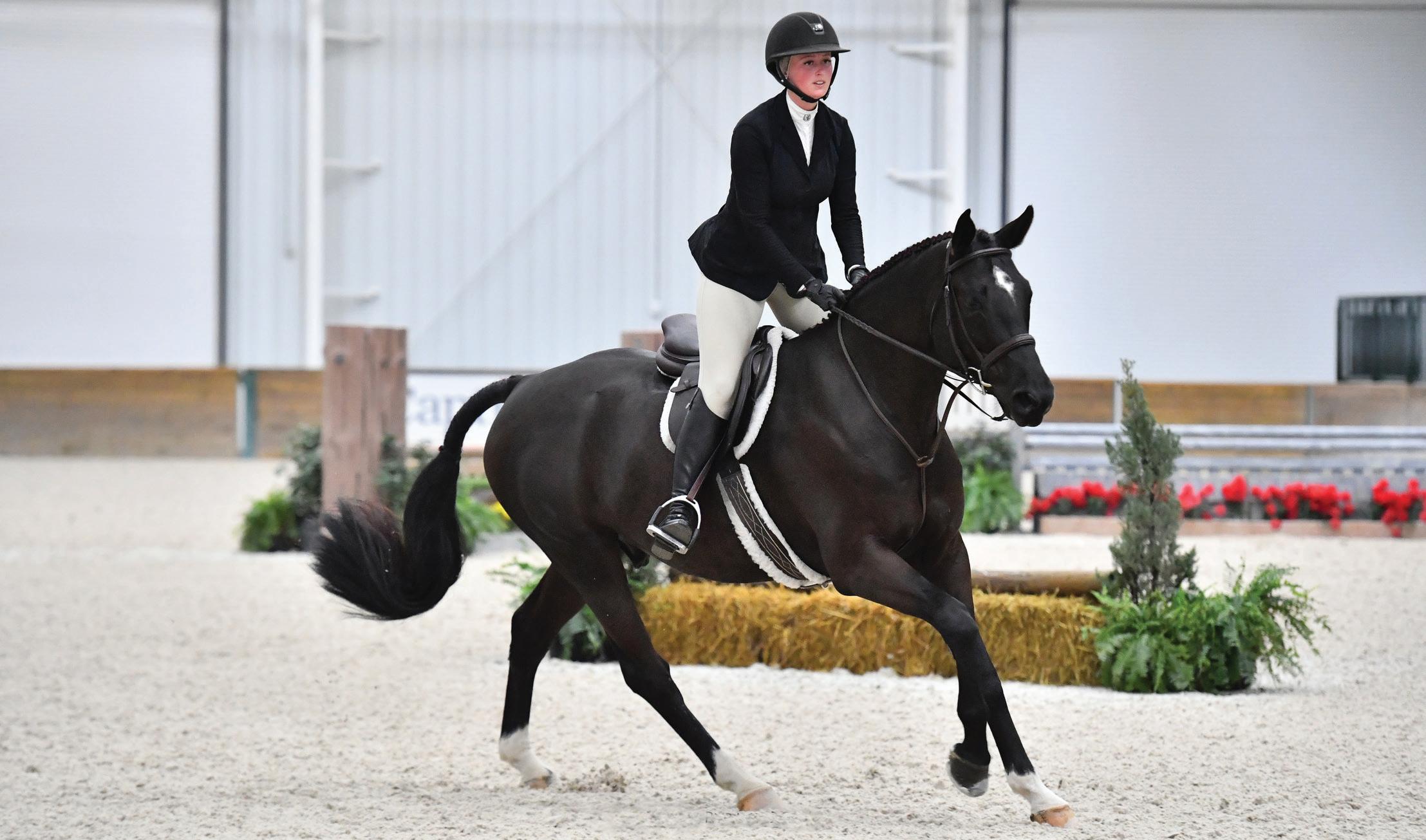

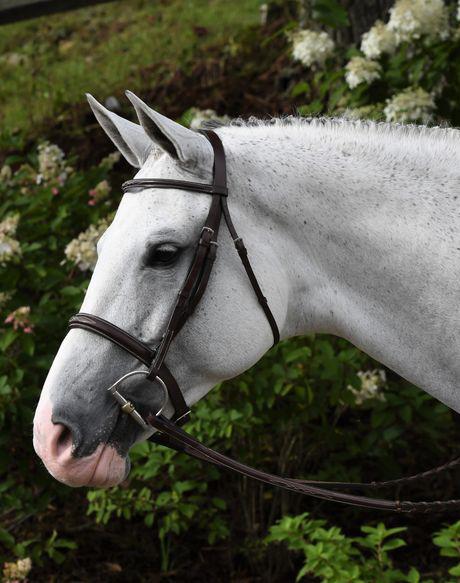

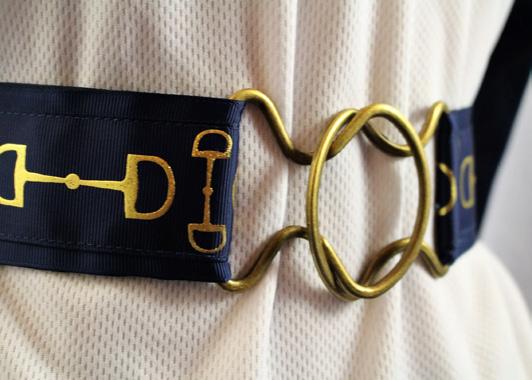

The Sandhills is a wonderful place to live, but our summer weather does bring with it some ‘nuisance pests’ that if managed properly can be a lot less pesty! We are lucky to have several companies and service providers in our area that offer Nuisance Pests maintenance packages.
Canady’s Termite and Pest Control, locally owned and operated since 1978, has an excellent reputation in providing my real estate clients with Termite and home pest control but also offers farm pest control for Mosquitoes, Fire Ants, Flies and even Rodents!
Our sandy soil which provides such amazing footing for our 4 legged friends is also desirable to both Subterranean Termites and Fire Ants. As a Realtor, I have been advising my residential and horse farm clients for years to purchase Termite Warranties for their homes and barns. Statistically, there can be up to 27 colonies of Termites per acre of land! It is very common to see barn and run-in sheds with wood to ground contact, and while the Termites might live in the soil they feed on wood!
to healthy horses and is a necessity when it comes to solid pasture maintenance. It’s recommended to treat your fields and properties bi-annually in spring and late autumn.
Flies are always a dilemma in barns in the summertime. While an internal Fly Spray System is a good way to manage that, they are expensive and come with maintenance needs of their own. Canady’s offers a fly bait system that can be installed in your barns and run-in sheds that will control your fly population. With their maintenance package Canady’s will visit monthly to ensure the bait systems are full and operational.
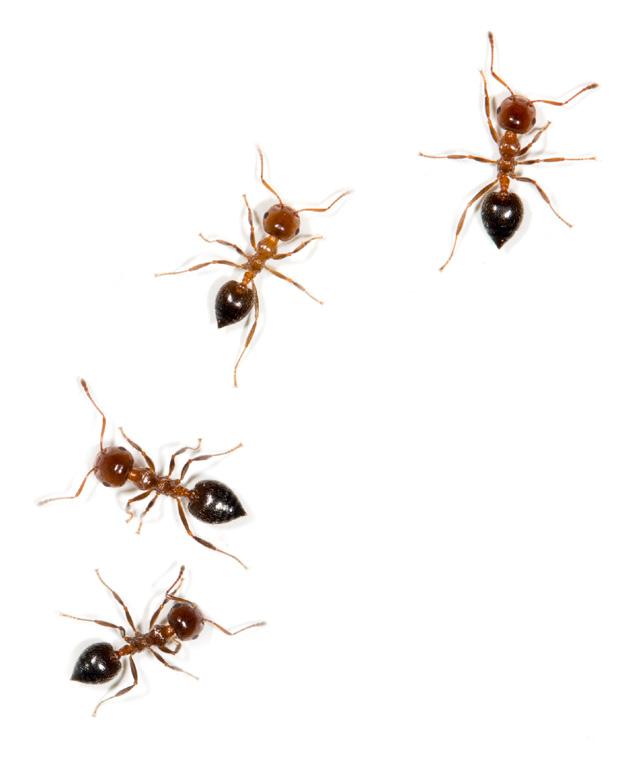
We all know what fire ant bites can do to our horses legs…. they burn, itch and fester and can cause swelling. Typically, fire ants start emerging in late April and then go dormant for the winter as soon as the ground temperatures cool. Fire Ant control is essential
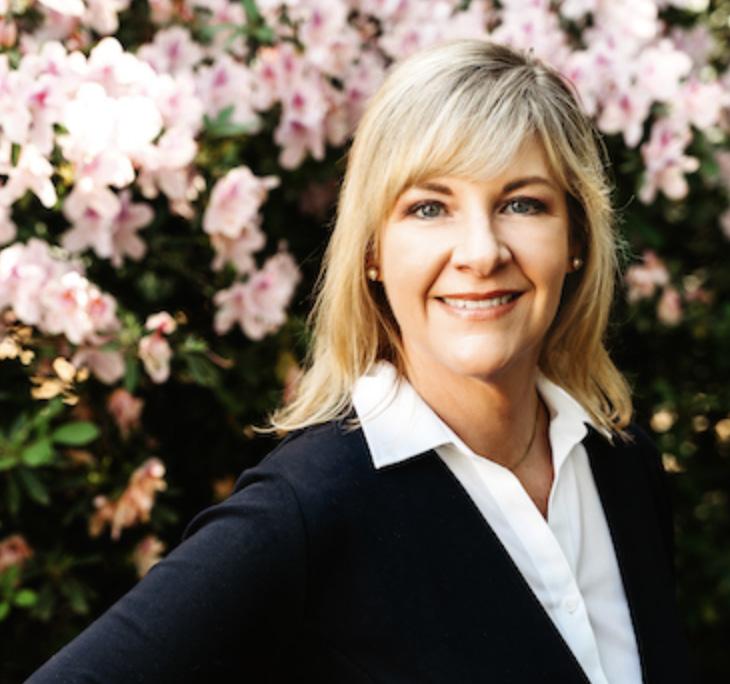

Neil McNeil, regional manager of the Moore and Cumberland County Canady’s offices says that the company welcomes calls from horse farm owners. “We offer free consultations and site visits so that a nuisance pest maintenance plan can be put in place to fit that farm’s needs. There are many factors to consider and Canady’s is dedicated to providing great service and results!”
A farm of any size is a real estate investment and a nuisance pest plan will help protect that investment and value for the future!
Audrey Wiggins has been serving Moore County and surrounding areas since 2002. Her expertise includes Horse Farms and Equestrian properties, working with Military Relocation, Investment properties, New Construction, Golf/ Luxury properties. She is consistently ranked in the top 1% of sales in the Mid Carolina Region Association of Realtors and is a Better Homes and Gardens Real Estate Elite Award winner which is awarded to the top 3% BHGRE agents in the country.





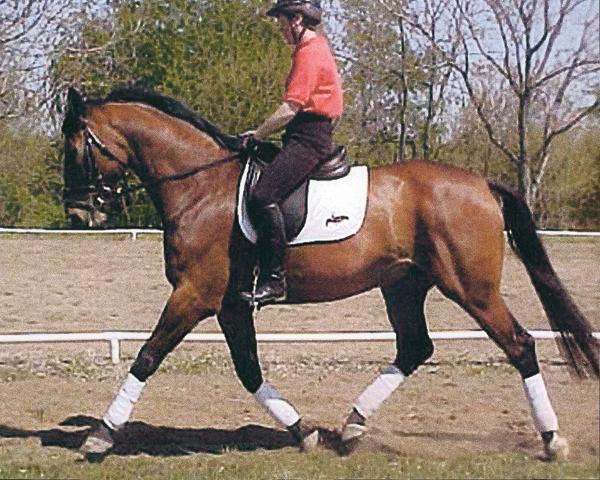




We are Equine Industry Innovators who create performance products to improve your horse’s training & show experience. Just like you, we are riders, competitors, and equine enthusiasts. EHI originated and is located and operated right in the heart of the Sandhills, NC!
Your performance is our passion!



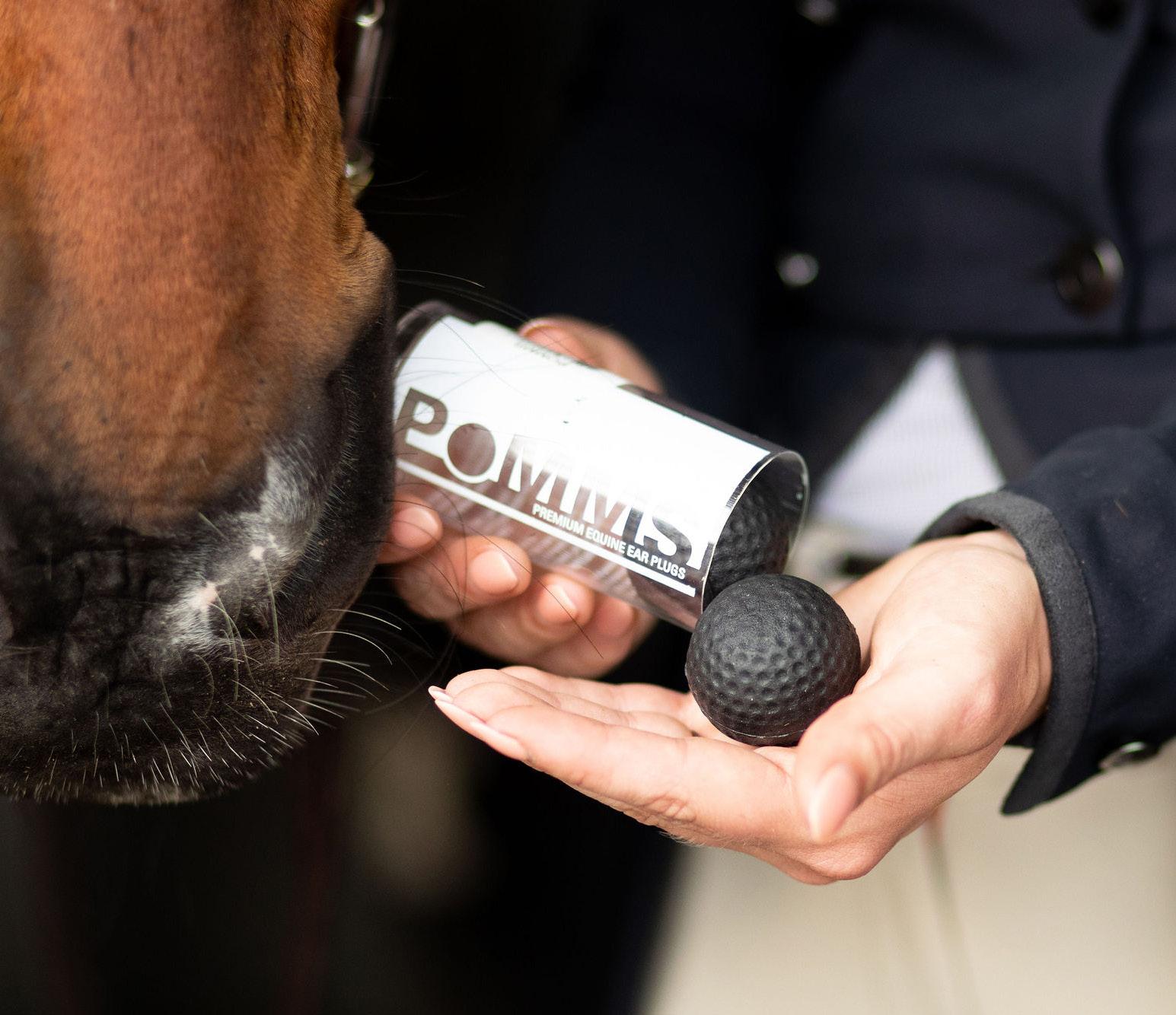


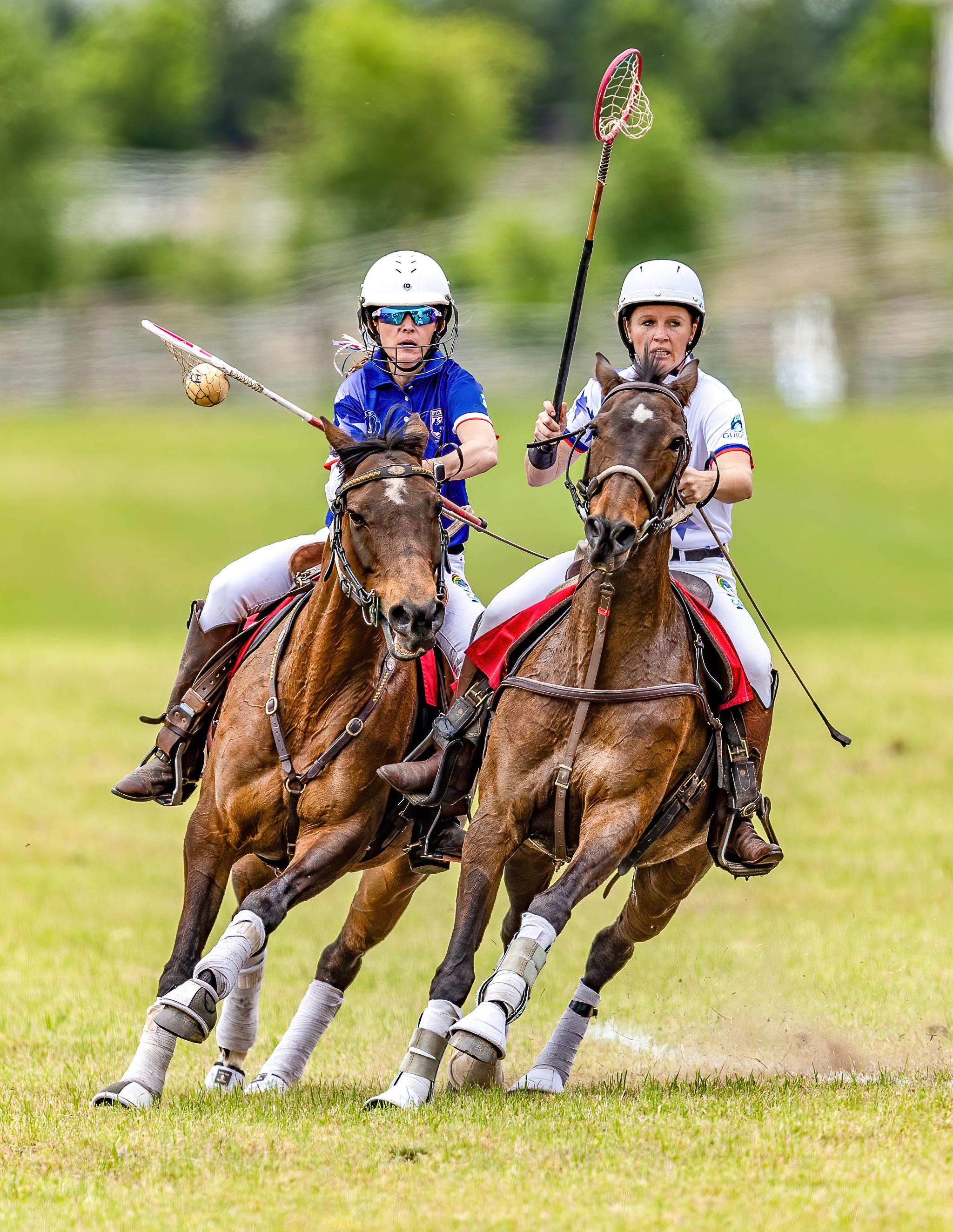

They ride onto their playing field of choice wearing bulky leather knee guards and helmets designed to protect in the event of a racquet to the face as well as an unplanned dismount. But high-level polocrosse players are generally some of the most easygoing elite equestrians you’ll ever meet.
It turns out that you can leave an awful lot of tension on the field in a game that involves making split-second decisions at a flat-out gallop to outmaneuver and outscore the opposing team. The sport is even more intense than it sounds, but Carolina Polocrosse Club members Rahul and Sarah Desai and Kat Liner thrive on it. They’ve gotten so good, in fact, that they’ve all been named to the squad set to represent the United States at the Polocrosse World Cup this summer. Liner’s boyfriend Karl Balogh, a recent transplant from the Sugarloaf Mountain club in Maryland, will also be on the team.
The 2024 Polocrosse World Cup in South Africa this summer will have little in common with international competitions in other disciplines. There are no six- or seven-figure horses involved — and that isn’t just because polocrosse players tend to train their own horses in the sport. Each player on the eight teams represented will ride a borrowed horse sourced from the local area, as is the norm for international polocrosse tournaments.
Photos: Jason JacksonPolocrosse might be the last truly amateur equestrian sport, still achievable at the highest level to anyone willing to make the effort. Up through the World Cup level the athletes are typically pharmacists and farmers, students and teachers for whom the sport is a hobby and a passion. Rahul and Sarah Desai are both physician’s assistants whose patients and colleagues are vaguely aware that they spend a lot of time playing something kind of like polo.
“People ask us all the time how can I play competitively or how did you guys get there, and I always remind them that everyone started where you are,” said Rahul. “Nobody was born able to do any sport. If you have the dream and are willing to put the work in and seek the right help, there are people who are more than willing to help you. You just have to have the mindset and the desire to do it.”
One of 32 clubs registered with the American Polocrosse Association, Carolina Polocrosse holds practices at least twice a month at the Pinehurst Harness Track. The Desais are based in Greensboro, so it’s a bit of a haul — and that’s just one of the geographic challenges of polocrosse. Active U.S. players number in the hundreds, and they’re scattered all around the country. Only a dozen or so countries have any kind of polocrosse community, so access to top competition requires traveling
overseas. In addition to the United States and the host nation of South Africa, teams from Australia, New Zealand, England, Ireland, Zambia and Zimbabwe will contest this year’s World Cup.
“We burn rubber up and down the highway, that’s for sure. People get hooked on polocrosse pretty easily, but when they find out that the next tournament is six or seven hours away that’s a deterrent,” Rahul says. “Compare that to the likes of Australia, for example, they have in the range of 6 to 8,000 players, maybe 100 at the World Cup level. So it’s a very different playing field.”
Polocrosse has its roots in England where it was developed to teach beginning riders balance and control. It ebbed and waned in popularity around the world in the first part of the 20th century, taking off most notably in Australia in the 1930s. The sport might be most accurately described as mounted lacrosse, and it requires a similar skillset to polo. It also shares some terminology with that better-known relative: each match is divided into six-minute periods called “chukkas.”
As polo’s younger cousin, though, polocrosse is the egalitarian, athletic, beer drinker of the two. In polocrosse, the six players on the field at a time are confined to a 160-by-60 yard area one-
fifth the size of a standard polo field. So not only is the action easier to watch, there’s more of it and it happens more quickly. Where polo players utilize a string of ponies for each match, polocrosse players are typically limited to one mount per game. Substitutions are occasionally allowed in the event of a horse injury.
Both Desais, Liner and Balogh played on the national team for the 2019 World Cup in Australia. They’re among about 15 players in the United States rated at the top of the one-to-10 scale used to gauge players’ ability. Based on ball skills, horsemanship and use of strategy in play, riders rated at 9 or 10 are considered to be reliably competitive at the “A” grade of play. Megan Swift and Braxton Hamlin of the Tennessee Valley Polocrosse Club and Lone Star teammates Dori Johnson and Houston Hutcherson will round out the eight-member World Cup team. Swift and Hamlin are also returning to the squad from the 2019 team, which finished the tournament at the bottom of the pack.
“Last time we were just kind of thrown into it because a lot of our team was pretty new,” Liner recalled. “The biggest thing we took away from it is we’re so much slower than other countries. They were so quick to get to the ball and convert it really well so that’s something we’ve been working on the last couple of years.”
heading up the American Polocrosse Association’s World Cup committee. Balogh also learned to play at a young age from his parents and older brothers.
As teenagers, both were selected by the American Polocrosse Association to participate in competitive tours and player exchanges internationally. Even as an individual, to play polocrosse is
will bring an additional four years of experience and rapport to the field in South Africa. “Now that we’ve kind of all been playing together for four-ish years I think we’re definitely playing a lot better polocrosse with each other now, so it will be cool to see how we pull together for this World Cup coming up.”

Ball skills and strategy are only one facet of polocrosse, though. For the Americans, essentially catch-riding through the most demanding competition they’ve ever faced is another.
“We learned that we were much closer than we thought we were in terms of being able to compete at that level, because all of our games were very close. Most of them were games we were leading and didn’t maintain it. Part of our job this time around will be making sure we keep the momentum,” Sarah said. “We learned that horse management is very important, trying to find the right combination of riders and horses. It’s a really delicate art which I don’t think we were very skilled at last time.
It’s not that they were new to international competition: polocrosse offers more opportunities than most sports for young talent to play abroad. Liner picked up the sport at Muddy Creek Farm, just down the road from her childhood home in Whispering Pines. So did her family. Her parents and brother play, and her dad Wade is
to be a member of a global support network. If you have the time and a plane ticket, someone will find you a bed to sleep in and horse to ride when you get there.
“We went on a lot of these youth tours. We’ve been to Australia, New Zealand and South Africa and being able to travel you make friends all over the world playing competitive polocrosse,” said Balogh, who with the other five returning World Cup team members
South Africa will provide more than 100 horses for the World Cup: 12 for each of the eight teams as well as reserve horses. Horses are rated and grouped into nine “pools” of roughly similar capability. Each team, including the host country, will be assigned a pool at random on July 16, four days before the first games of the tournament. Teams will have about an hour each day for four days to evaluate their pool and get a sense of how those 12 horses match up with their eight riders based on riding style and which positions they play best. In polocrosse, each team’s No.1 player is
the only one permitted to score. The No. 3 player is restricted to the defensive position near the goalposts, and the No. 2 players are midfielders.
“There are players that are phenomenal and clearly better than others, but when you make it to a World Cup the gap in skill level is quite narrow,” said Rahul. “When you pair it up with the horse power and the coaching to match the right player with the right horse, that can prove to be the difference maker moreso than the skill level of the players.”
Enhancing that skill in a sport that demands a particularly high level of athletic training has to fall in line with full-time jobs and other commitments. Having significant others in the game just makes it all manageable. Liner graduated from The University of North Carolina a few years ago and works as an echo tech at Moore Regional Hospital while applying to physician’s assistant school.
“Usually something kind of goes by the wayside and recently it’s been sleep,” she said. “Balancing applications and work it definitely is a lot, but it’s so hard to quit. It is super helpful having Karl to help and motivate me to go out and ride, especially on days after work when I want nothing less than to go out in the heat and tack up.”
For the Desais, teamwork on the polocrosse field extends to what might be an even more hectic day-to-day of managing careers in medicine, eight horses at home, and their two young sons Krish and Kiren. Working out and riding usually bookend 12-hour shifts in a schedule that starts at 5 a.m.
“It’s more of an understanding of the requirements and the sacrifice we have to make, that level of understanding of what each other is going through. At the end of the day I’m holding myself accountable and the team is relying on me,” Rahul said. “When you’re out there, even though it’s only six minutes
at a time, it’s flat out gallops most of the time while trying to focus on the ball. Add the slightest bit of physical or mental fatigue with distraction and before you know it you’re performing at 70 percent of your peak.”
“We can push each other. When I’ve been working all day and I’ve got to cook dinner and get them to bed, it’s hard for me to say I’m going to do a Peloton workout or work on my racquet work,” Sarah added. “The kids also like to play, they enjoy the traveling, so they come and they know everybody at the tournament, Krish was 15 months old when we took him to the last World Cup. There’s no resentment about the time that we’re having to spend because we all do it together.”
The Desais keep their five active polocrosse horses at home along with two young prospects and their kids’ pony. The mix includes a few Thoroughbreds —15 hands, please, Sarah says — a Quarter Horse, and two Australian

Stock Horse/Thoroughbred crosses. They’ve developed their own horses in a process that takes about three years from green broke to their first chukka in a high-level game. Breed, Rahul says, is less important than “athleticism and a brain,” and the willingness to work hard.
“At the end of the day if the horse is not having fun, it’s just not a good combination,” he said. “We luckily have some that if you just look at them when they get near the field you can tell they really love to play. One would run up to the barn if you turn on the clippers and stand there waiting to have his mane clipped because he knew what that meant.”
Sarah comes from a dressage and eventing background, but she also competed in tetrathlons – combining running, shooting, swimming and riding — before she discovered polocrosse through Pony Club.
“A lot of people will probably tell you that our standards are much higher than the average polocrosse player,” she said. “I don’t want to fight my horse, I don’t want my horse running around with his head in the air. I expect a certain level of responsiveness. It takes about two years once they’re able to get on the field to where we’re really happy with where they are.”
Rahul was born in South Africa and grew up in Zimbabwe, where he learned the sport before his family emigrated to the United States. The chance to play in a World Cup together in his homeland has motivated the couple since the last World Cup in Australia.
“After the 2019 World Cup we had some decisions to make: we were fortunate that we’re still competing at the top level in the US,” Rahul said. “The commitment to playing in the World Cup is such a big task. It’’s probably the last time that both of us will be able to
be on it together and the fact that it’s in South Africa is a nice icing on the cake. I still have family there and take every opportunity to go back home.”
The United States is scheduled to play defending champions Australia, as well as Zambia and the United Kingdom, in the first three days of the World Cup tournament at the Durban Shongweni Club in KwaZulu-Natal. New Zealand, Zimbabwe, Ireland and South Africa will play in another pool. Teams will be ranked within their pools based on the first three days of play, and those rankings will determine the next three days of matches leading up to the July 28 championship game.
“My biggest goal is to leave everything on the field,” said Liner. “I would hate to be on the flight home wishing I’d gone after the ball a little harder.”

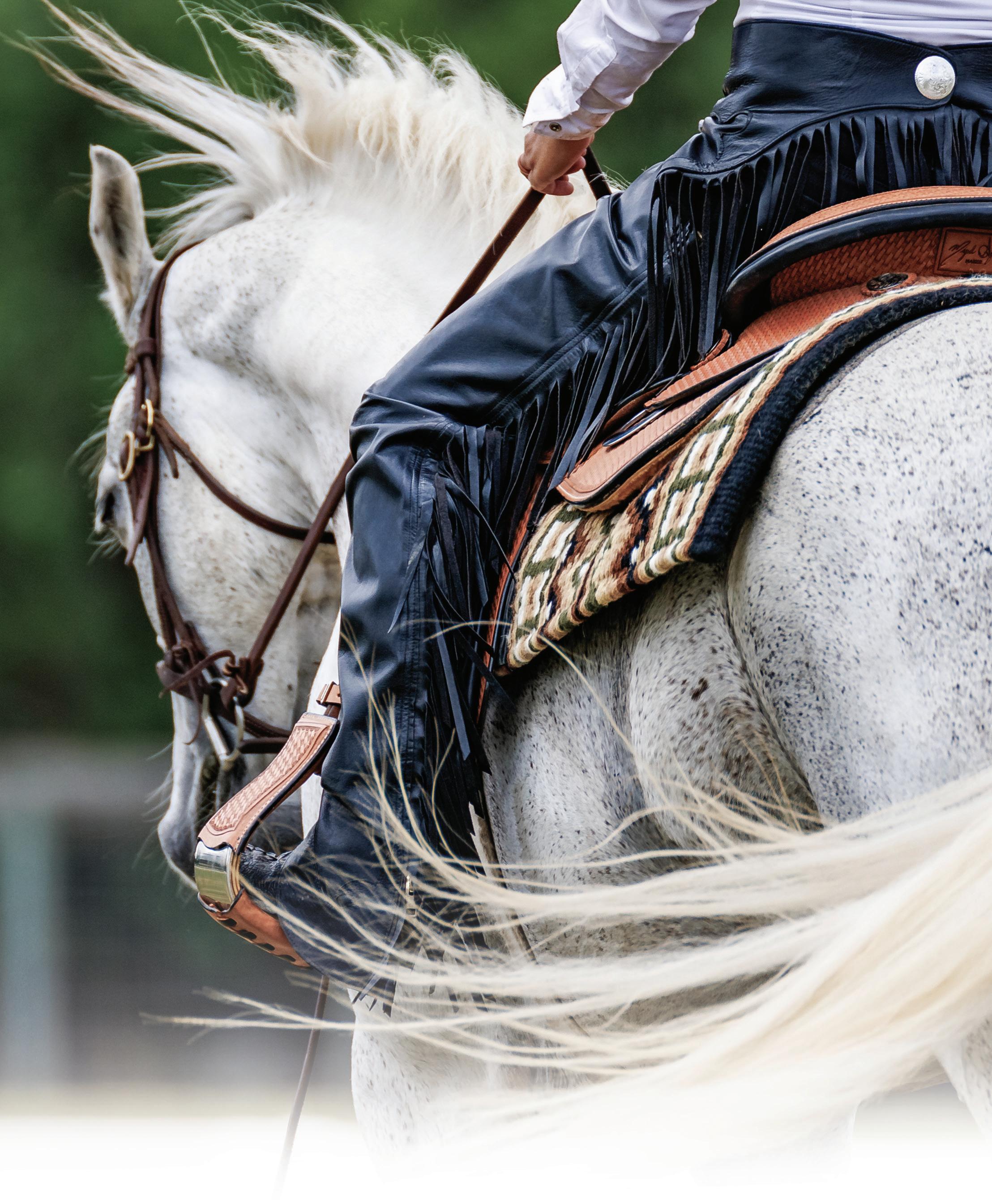
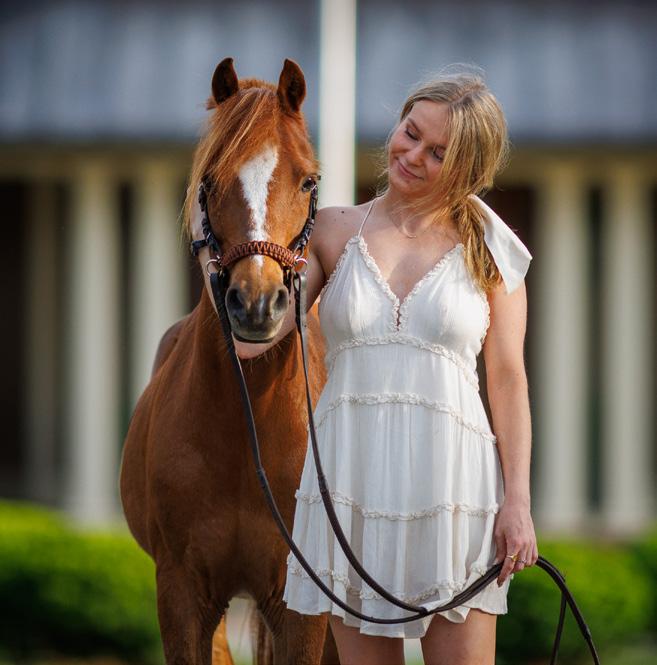


Since the early 1970s, Kay Whitlock has been a leading Southern Pines citizen and a dedicated student of equestrian sports. Known throughout the town for her kind nature, she was a founder of the North Carolina Dressage and Combined Training Association (NCDCTA) and received their Lifetime Achievement Award in 2023.
She says winning the award was a shock. When they called, she asked if they were sure they were calling the right person. “I’ve worked really hard over the years,” she says. “I became involved with the association around 1978 and held every position on the board, including president twice and vice president.”
“I grew up in a little house on Long Island,” she says. “I just couldn’t understand why we couldn’t have a horse in the garage. I ended up in New York City and rode a couple of times in the Hamptons. That was about it until I moved to Southern Pines. It was a passion, but I really didn’t start with horses until I was 32. At first I was eventing and foxhunting, but was attracted to dressage because I enjoyed the attention to details the discipline required.”

While Whitlock didn’t study business in college, she had a head for it right from the start. She got a job as a clothing buyer for a large department store complex and that set her up for being a bit more discerning because she had to be. “I could easily have transferred to a store in Colorado or Florida,” she says. “But I saw a glass ceiling in that line of work, so I went out on my own.”
Whitlock’s parents had retired in Whispering Pines and that’s how she found Southern Pines. She drove down main street, saw all the little houses, and wondered how people made a living. That piqued her interest in moving to the town. After she made the move, she opened a clothing store for seasonal wear and eventually opened Twice As Nice, a resale apparel shop. Soon after her arrival, she got a ‘free’ horse that turned out to be lame and pregnant but that was enough to solidify her start in the saddle.
One day, she rode up a hilltop off Young’s Road, back when there was still a lot of open land. At this vantage point she said, “Someday I’m going to own land over here.” She was later
introduced to a Southern Pines Horse Country landowner who let her buy a tract of land. It turned out to be the very same hilltop that she had wanted a couple years earlier. And this was the beginning of Viewpoint Dressage.
“I started with schooling shows at my farm before there were any neighboring houses,” she says. “People would come with their trailers and park all around. We had spring shows starting with combined tests and dressage. When everybody got comfortable with that, I began doing the recognized shows. I went over to Pinehurst and asked if they could regrade the track after the trotters so that I could use their facility. We went down to Aiken and started a popular show down there, and we were running shows around the state. Ultimately, I stayed with Pinehurst and it’s worked out great.”
“I have a core group of folks on the payroll. I also have volunteers who are just amazing. They’re with me a couple of different times a year. A person can volunteer even if they don’t have an equestrian background. I start them
out helping with low-level tests so they can see how things operate. I also give them a list of the abbreviation symbols we use. Anybody that doesn’t talk a lot and has a serious interest can do it. It’s also helpful for new riders to volunteer so they can better understand how dressage is scored.”
“When I started out, I had a good time showing. However, it was challenging for me to compete while running the shows. Sometimes I tried and that didn’t work out so well. I didn’t have any money, that was the main thing, so I had to train them myself with different mentors. I never spent that much on a horse. I got some off the track and had some interesting times.”
“In many ways, I think this was a wonderful experience, helping me become a more sympathetic judge. It also helped me to grow in my understanding of the training scale, and the learning that comes from advancing through the levels. The shows that I run are basically geared toward the adult amateur and I try very hard to make their weekends pleasurable. This is their vacation time and it’s all the money they have. I want them to have a good time even if their scores aren’t so good. For me, judging is giving back and a labor of love.”
things I look for all the way up,” she says. “And of course, at Training Level you are just pleased if the horse is just going around happily. I love seeing a rider who truly cares about their horses. I also love seeing a desire to learn and respect for the discipline of
bother me. I did my own thing. I just told my niece that. She’s going to Tryon to be judged by real judges. I told her to be accurate, that’s the most important thing. If you miss one square just keep going.”

dressage. And best of all, I like seeing a rider who has a true relationship with their horse.”
In terms of judging dressage, first and foremost Whitlock wants to see harmony and an understanding of the figures. For example, doing a 20-meter circle instead of a square to show the suppleness of the horse. “Those are
“As you go through the levels, you see an increase in the training and engagement. The front will be a little lighter and there’s a little less on the forehand and it’s still up. That’s what you’re looking for. You’re also looking for accuracy. At times some of the judges didn’t agree with me but it didn’t
The lucky path that led her to the Sandhills isn’t lost on Whitlock.
“There’s not much I don’t love about Southern Pines,” she explains. “I pinch myself every time I drive home, thinking how lucky I am to have landed here instead of the suburbs somewhere up north. From my back porch I can close my eyes and feel like I’m in the mountains or at the beach. This place is just amazing but everybody else knows it too.”
“The area is growing and I’m grateful for the people who had the vision to keep the open woods. I had a long meeting this morning with Larry Best, past president of the WalthourMoss Foundation. We talked about putting easements and protective covenants on my property so that the land can’t be subdivided. We’re working very strongly on that now, trying to hang on to what we have.”
Whitlock appreciates all the resources of the area, not just the open land and equestrian opportunities.
“For a long time, I went to Tom Thompson’s meditation classes and I wish he was still here. It helped me through some terrible times, a nasty divorce that took years and the loss of my daughter. Meditation helped me to still my mind and learn to control my feelings. I think it helped a lot with my riding because I would overthink
what I was working on and what I expected out of it. Instead of getting upset, I began trying to figure out why something wasn’t working. That was all part of my experience with meditation – it changed my life 100%.”
“Coming back to life situations, the death of my daughter was a huge challenge,” she says. “That and being able to afford dressage. It was a balancing act, because I remarried and ended up with three more children. I had to learn to be more forgiving, so I’m not quite as tough as I used to be. I have no regrets. Well, wouldn’t it be nice to have more money, but I see people with a lot of money with very expensive horses who aren’t happy.”
“As far as the future of dressage, it’s getting bigger and bigger. That’s

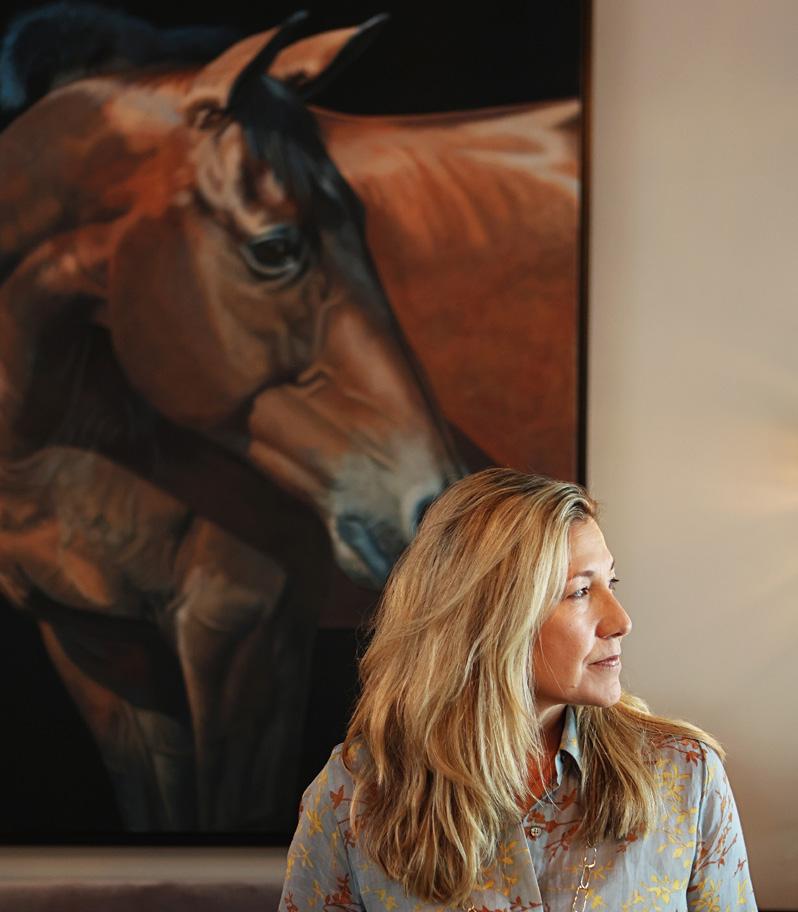

basically because the land is getting less and less. Disciplines like eventing that require a lot of space are struggling. Dressage being self-contained is becoming more popular. It’s also safer. That’s a big issue for people who rely on their job to be able to keep their horse and also have a family.”
“I was never born into any of this,” she says with a smile. “What I have and what I’ve been able to do is amazing. While I’m no longer involved with the NCDCTA, I continue doing the shows out at Pinehurst Harness Track. I do miss riding – so I’m looking for a new passion right now.”

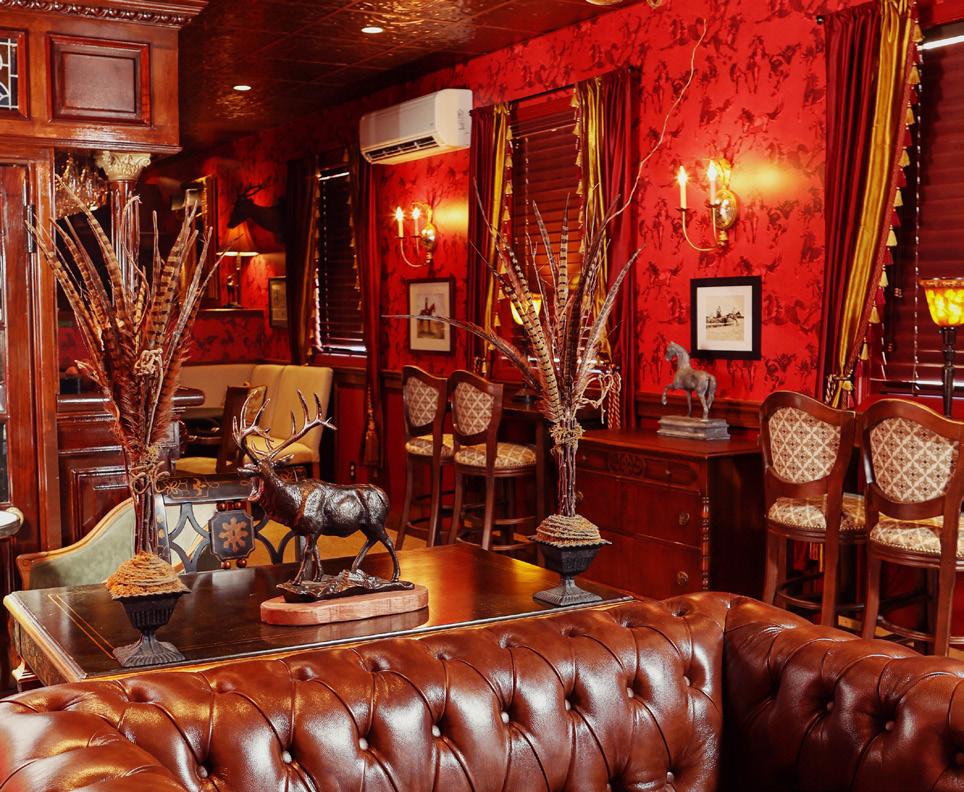


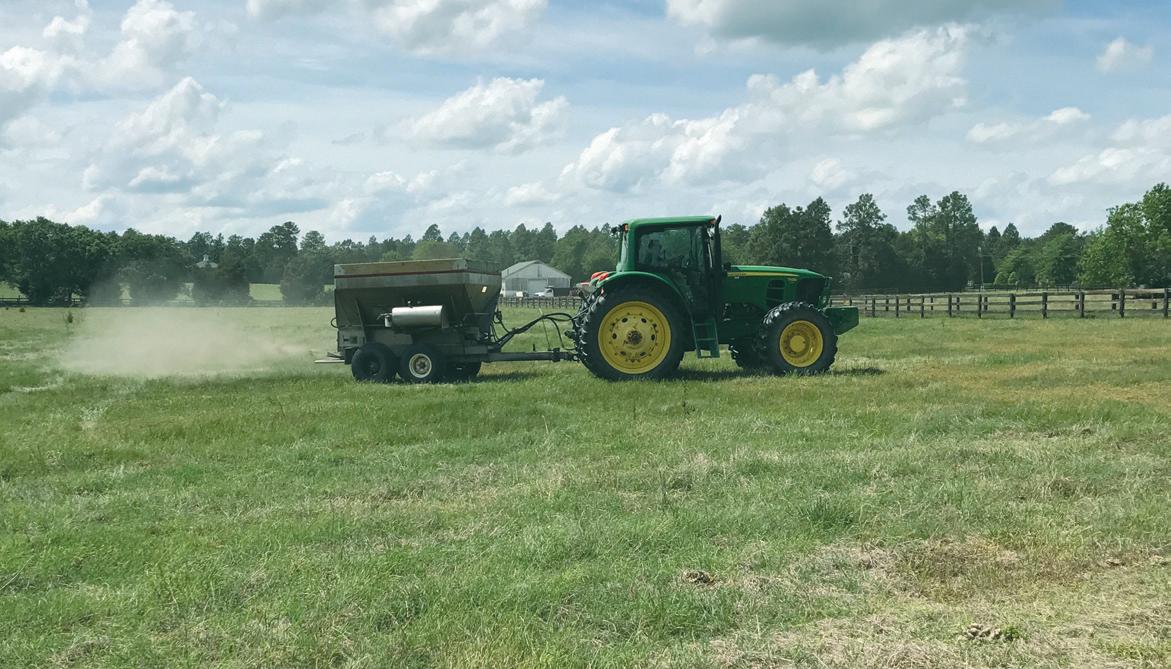
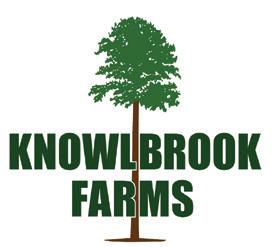



There’s something about seeing equestrian-inspired things in the wild that makes all the time growing up as the ‘weird horse girl’ completely worthwhile.
When a beautiful model struts down the runway in shipping boots, my pony-themed Lisa Frank hoodie gives a knowing nod. When I walk into a store featuring knee high “equestrian” boots and completely impractical “breeches”, my dirty Dubarry knockoffs and stained riding breeches seem less awkward and more fashionable. And when a hotel features a beautiful horse over my bed, I sleep far more sound knowing the gods of the holy half halt are watching over my slumbers.
The equestrian brand is definitely becoming more common in places outside the barn. All those little kids who grew up with unfashionable (ok, maybe they were horrendous) horse graphic tees and a bag full of Breyers have now become CEOs, dentists, doctors, and chefs, bringing their horse-loving roots into far more socially acceptable appearances.
For non-equestrians, walking into a business that has a racing picture on the wall or an entire dedicated theme
might bring back nostalgic memories of a pony ride at the fair or aunt who had horses.
But for those in the lifestyle, we know there is a story behind the theme. Even if it’s not apparent what that story may be, we know that each item was bred by a dream that involved horses.
For those planning on an eclectic dinner out at Raleigh’s iconic Angus Barn, it probably comes as no surprise that a restaurant with “barn” in the title has sections completely dedicated to the equestrian brand. The footprint of the establishment features rooms of different ‘feels’, ranging from The Wild Turkey Lounge, which was featured as one of “One of the Best Business Bars in America” by Entrepreneur Magazine, to the Wine Cellar Dining, where visitors are treated to one of the most coveted wine lists in the United States.
While the Angus Barn is known for its extravagant holiday decorations, including a spectacular Christmas display - where it is nearly impossible to get a reservation - equestrian visitors might be more inclined to spend their
time in the women’s bathroom. Yes, the bathroom.
While much of the decor follows the barn theme, it typically trends towards the whimsy of the American West where visitors feel like they’ve been transported to a saloon, with their horses forgotten outside, tied to a pole.
But the ladies room of the lounge section transports users to an Instagram worthy horse barn, with elegant lighting, ‘stall’ doors (literally), and an inviting sitting area.
For local equestrian family Brandy and Travis Bailey and their children Ava Brook and Wrenn, visiting the Angus Barn brings all the happiness of their ‘stable life’ to their dinner experience.
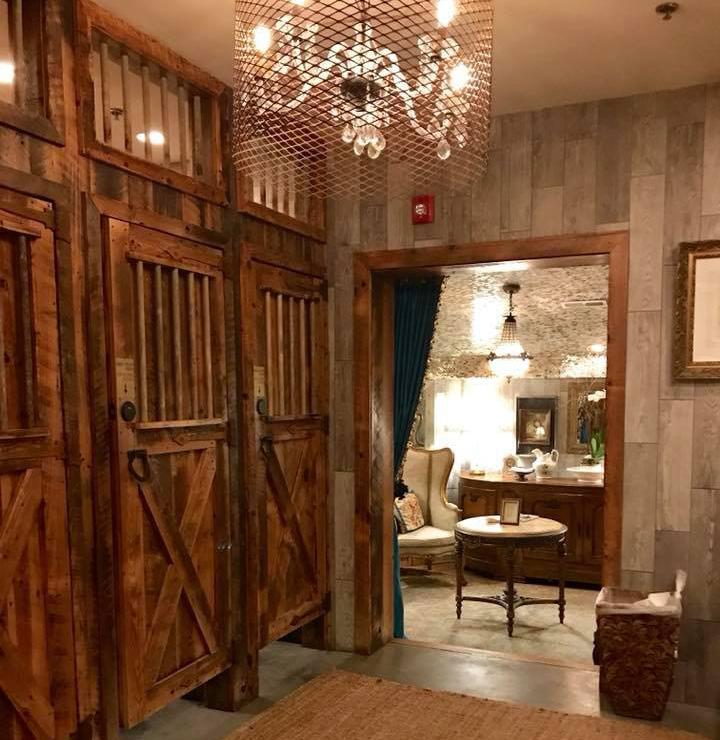

“Being we are an equestrian family, our absolute favorite place to be is always at the barn with our beloved ponies,” reflected Brandy. “When it’s time to go out and celebrate a special event or just have dinner on a whim, The Angus Barn is always our favorite place to go. The rustic elegance of its actual barn setting both inside and out, that includes hay troughs hanging among hallways to the lovely authentic stalls in the ladies lounge, is a true feeling of relaxation and tranquility because wherever the presence of the barn or ponies are, we find the most happiness! This awesome setting paired with a delicious meal is pure delight for our equestrian family.”
For a slightly less relaxing outing, visitors to the Derby Dental practice in Pinehurst are treated to a complete equine-themed space. Stable doors,

larger-than-life pictures, saddles, helmets, and even horse activities in the waiting room, the office specializes in kids and those with special dental needs. Because we all know that the barn brings a sense of calm to everyone… most of the time.
For some, the equestrian influence comes from a lifestyle that they have been brought into by family members. For the majority of his career as a compliance officer at Duke University, Jim Luther has spent his weekends engulfed in the equestrian world, fulfilling his role as an equestrian’s husband and dad.
When he moved to starting his own consulting company, where he “supports various clients in developing compliance programs based on the fundamentals of an effective internal control environment,” Jim turned the naming of his new business over to his wife, Libby. Like most equestrians, she knew how the drive, commitment, and philosophies of the equestrian world translated to the needs of corporate America.
“I googled horse terms for hours. Wanted something horsey, but also something only horsey people would get - since the company relates to compliance and *nothing* to do with horses,” Libby reflected. “I looked at saddle parts, anatomy, training terms, etc., and then the dressage training pyramid just came to me and Impulsion seemed perfect.”
For equestrians who are heavily involved as competitors or professional trainers, continuing their outside activities with equestrian flavor is a natural transition. For local equestrian professional, Anne Dekyser, that vein has grown in several different directions.
First it was branching out in pilates, where she marries the techniques necessary for both practices to better each career. And recently it has been combining efforts with two other equestrian and business friends to build a horse trailer into the things cocktail dreams are made of.

Anne, along with Melissa Tatge and Ashley Van Camp, spent their socializing time, dreaming of converting a trailer into a cocktail bar, bringing an equestrian flare to the many social gatherings around the Sandhills area.
“We all socialized a lot - maybe too much? - within a great group of horse girl friends and we’d dream of converting a horse trailer into a bar because that just always felt right up our alleys,” recalled Melissa. “I know Ashley always kept her eye on trailers and would send them over to us, then this one popped up in her feed and I guess it was the ONE because here we are a year later! It’s been a total blast.”
“I think the novelty of the horse trailer captures non-horse people’s imagination also, maybe more so than the horsie crew,” she continued. “We served a holiday party in December that wasn’t exclusively Horse folks, and people are just happy to sidle up to the bar and chat with us. And ask for a beverage of course. We’re happy to chat and serve!”
Ashley was no stranger to shaking up horses and cocktails. She is the owner

In addition to the obvious equine decor, Ashten’s features many Easter Eggs that only equestrian clientele will pick up on, like the 52 Thoroughbreds and The Double Clear cocktails.

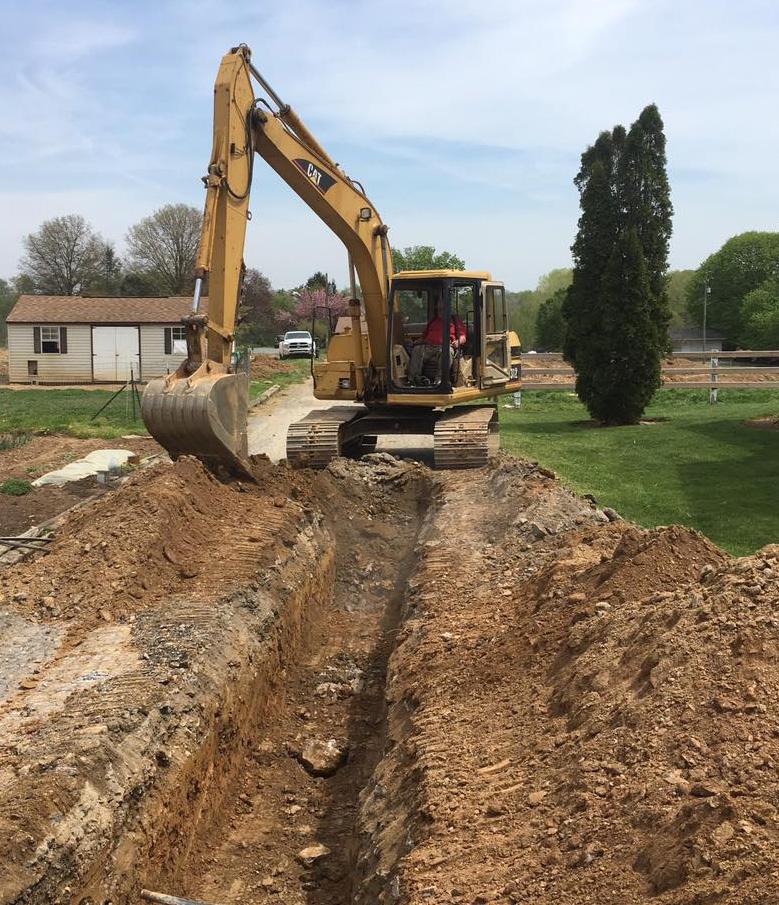

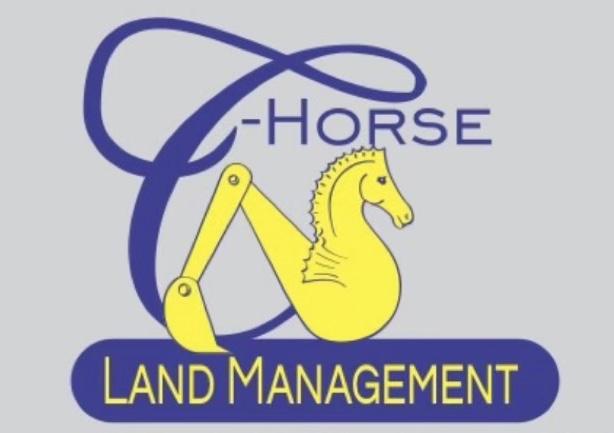
of area staple, Ashten’s restaurant. In addition to the obvious equine decor, Ashten’s features many Easter Eggs that only equestrian clientele will pick up on, like the 52 Thoroughbreds and The Double Clear cocktails.
“Ashten’s started because Southern Pines is historically a horse town,” Ashley explained. “If you go to Pinehurst, everything is golf. Southern Pines’s identity is horses. We want to tell the story of our area through our food and our ambiance and art. Many of the horse paintings in Ashten’s feature locals and are painted by local artists. I grew up in Southern Pines, riding with the Moore County Hounds and showing at our local shows. I am old enough to remember a lot of the old timers!”
“Who doesn't like horses?” concluded Anne. And we happen to agree.







Ed Oeltjen is the husband of eventing professional and dressage show organizer (and Sandhills Equine editor), Cassidy Oeltjen. He is also one of the founders of Equestrymen, “the support group for those who support their equestrians.” While he doesn’t have equestrian aspirations himself, he has learned to turn the camera sideways when videoing rides, and how to feed treats without getting fingers bitten.
1. You didn’t have much horse involvement growing up. What were your first impressions of horse shows?
In the early days, I had enjoyed the benefits of a fresh, new relationship. I got to shows and was given a comfy folding chair, asked what kind of beer I’d prefer, and sauntered to the ring just in time to watch her jump around some colored poles - blissfully unaware of just how much money she had dropped for that 86 seconds of glory.
And then the fresh relationship faded into the heat and humidity of the summer. My comfy chair was now stacked high with a sweaty saddle pad and other bits of unidentified equipment. And when I say unidentified, I mean, there is stuff that a lunch lady would wear, or a dominatrix, or maybe a soccer player, but they were for the horse!
I did talk to everyone, only finding out that they were Olympians, or upper level riders, or people of importance after I had told them about my wife’s horse who stopped at fence one or offered to go get them a beverage.
2. How did the idea for the ‘support group’ for horse dads and husbands get started?
It was pretty easy to notice the other guys in my predicament. We had the same exhausted look from following the rollercoaster of emotions experienced at horse shows. We were all lugging loads of saddles and sweaty items around, standing around looking pretty awkward.
As a husband to someone who not only actively competes, but also runs horse shows, I’ve felt just how the whole vibe of a show can change with some positive words and feeling of inclusion. I figured if the husbands and dads started to view a show weekend as a social outing with a sense of community, that the whole show itself would be elevated.
3. How can people get involved?
If they have an equestrian in their life, they are already a part of the group!
The feedback has been great because I think the equestrian community is so close knit, but those of us on the fringe of it feel sort of involved but not really. We really just want to bring people into the group, and make the horse show weekends more fun for everyone! We’ve grown to having apparel, giving awards, and always having a beer for our fellow brethren who look like they might be a little parched after all that time carrying sweaty saddle pads and cheering.
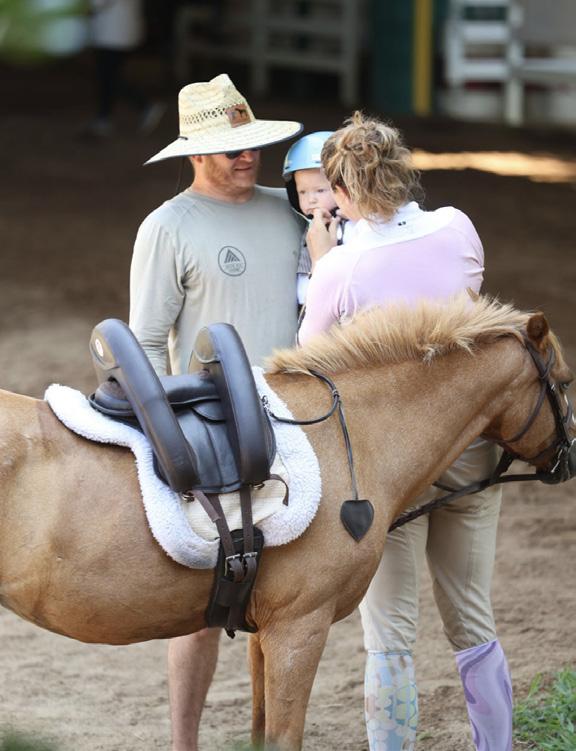



Age: 20
Gender: Mare
Breed: Arabian Color: White
Heigth:14H
Andi is a beautiful soul looking for her forever home. Andi is currently in light work as we build her body condition. Andi loves attention, is sound and healthy, and will do well as a casual trail horse. She is not for a complete beginner, but should do well with a novice or better rider.
Andi has great ground manners, easily loads on the trailer, pastures in a herd with geldings and mares, and stands well for the farrier.
Andi is available for adoption through the Renaissance Equine Rescue and Welfare Foundation
June 13-15
Thu-Sat
Capital City Classic (Saddle seat)
Hunt Horse Complex, 4601 Trinity Rd, Raleigh, NC 27607 www.lizholmeshorseshows.com
June 19
Wednesday
HRF D/CT/HT/WD
Heather Ridge Farm, 875 N Horace Walters Rd, Raeford, NC 28376 www.HeatherRidgeFarm.org
June 22-23
Sat-Sun
NCAHA Open (Arabians)
Summer Extravaganza
Hunt Horse Complex, 4601 Trinity Rd, Raleigh, NC 27607 www.ncaha.com
June 22-23
Sat-Sun
Dressage at the Park
Carolina Horse Park 2814 Montrose Road Raeford, NC 28376 www.sportingservices.net
June 29
Saturday Buckhorn Farm D/CT 434 Youngs Rd, Vass, NC 28394 www.BuckhornFarmSP.com
June 26-30
Wed--Sun
NCHJA Annual Show A
Carolina Horse Park
2814 Montrose Road Raeford, NC 28376 www. nchja.com
Jul 6 - Jul 7
Sat-Sun
WHES July HT
Carolina Horse Park, 2814 Montrose Road, Raeford, NC 28376 www.carolinahorsepark.com
JULY 10-14
Wed-Sun
State 4-H Horse Show
Hunt Horse Complex, 4601 Trinity Rd, Raleigh, NC 27607 equinehusbandry.ces.ncsu.edu
July 12-14
Fri-Sun
SATP Pony Finals Prep C
Carolina Horse Park 2814 Montrose Road Raeford, NC 28376 sedgefieldatthepark.com
July 13, 2024
DUE: Labor of Love Jr/YR Scholarship App www.ncdcta.org/junior-scholarship
July 13, 2024
OPEN: Labor of Love I & II www.ncdcta.org
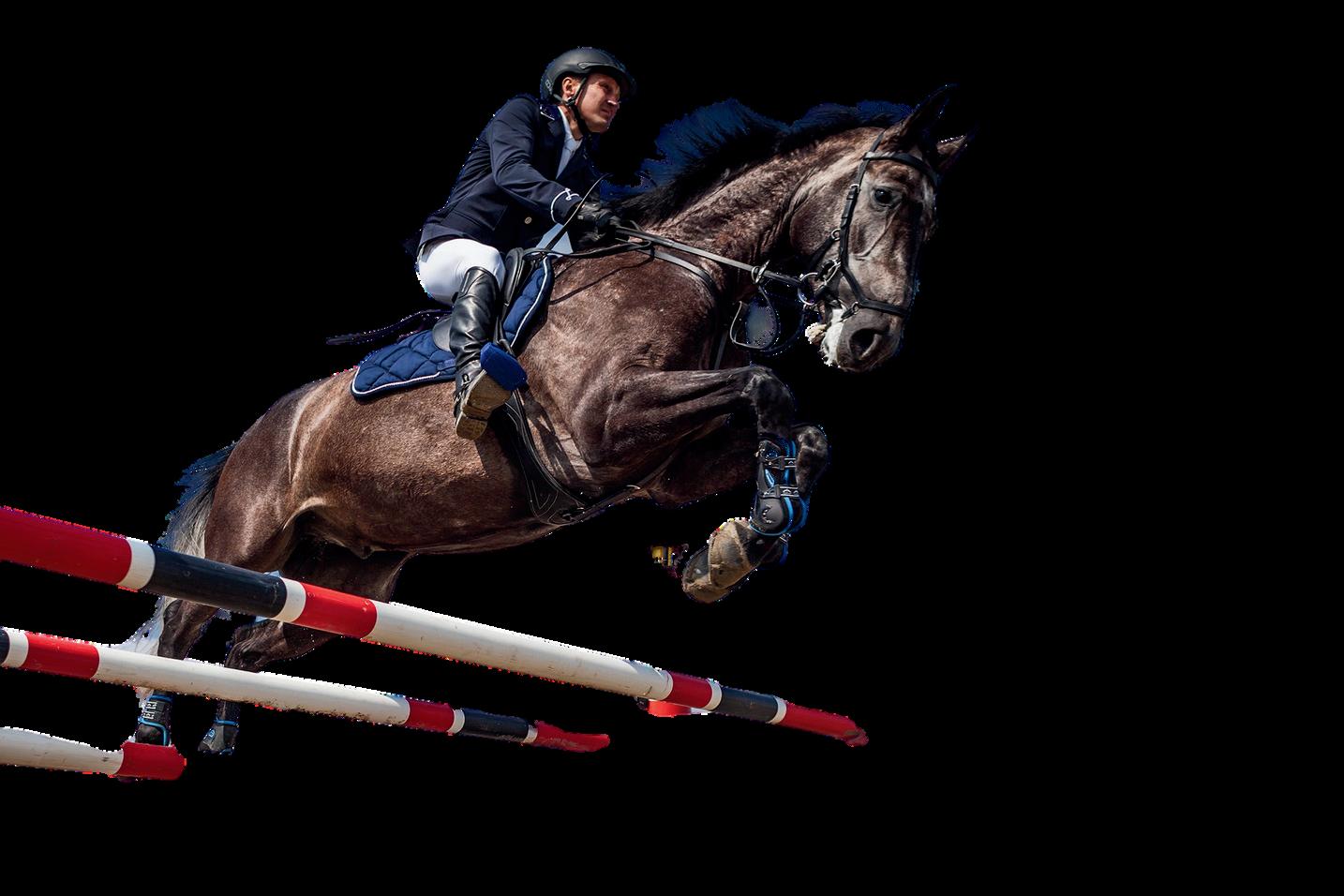

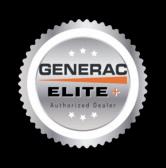





Jul 13 - Jul 14
Sat-Sun
Rise ‘n Shine
Pinehurst Harness Track, 200 Beulah Hill Rd, Pinehurst, NC 28374 www.carolinadressage.com
Jul 19 - Jul 21
Fri-Sun
NCDCTA Functional Anatomy Clinic www.eventcreate.com
Jul 19 - Jul 21
Fri-Sun
Triangle Farms Summer Indoors “C”
Hunt Horse Complex, 4601 Trinity Rd, Raleigh, NC 27607 trianglefarms.com
Jul 19 - Jul 21
Fri-Sun
TWHA July Show (Barn E Ring)
Hunt Horse Complex, 4601 Trinity Rd, Raleigh, NC 27607 www.trianglewidehorsemansassociation.com
July 24
Wednesday, HRF Picnics&Ponies D/CT/HT/WD
Heather Ridge Farm, 875 N Horace Walters Rd, Raeford, NC 28376 www.HeatherRidgeFarm.org
July 27
Saturday,
Triton Stable Show C 2521 Baptist Road Durham, NC 27703 www.tritonstables.net
July 27
Saturday, Buckhorn D/CT Buckhorn Farm, 434 Youngs Rd, Vass, NC 28394, www.BuckhornFarmSP.com


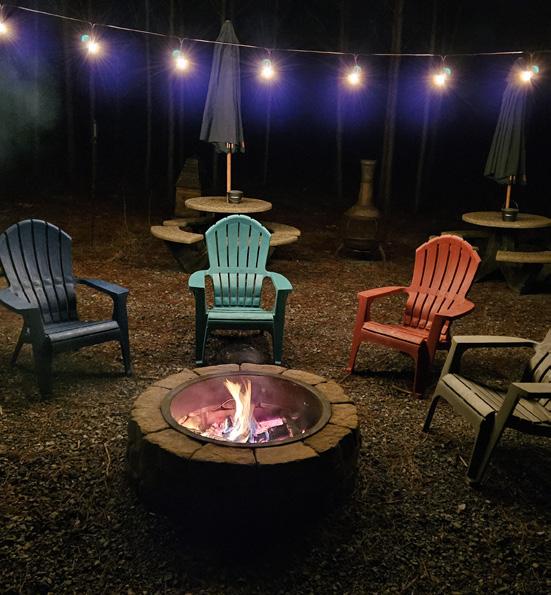
July 27
DUE: Harvest Moon Jr/YR
Scholarship Application www.ncdcta.org/junior-scholarship
July 27
OPEN: Harvest Moon / CBLMs www.ncdcta.org
July 27
Saturday,
Raleigh Summer Dressage I
Governor James B. Hunt Jr. Horse Complex, 4601 Trinity Rd, Raleigh, NC 27607 www.HorseShowOffice.com
July 28
Sunday,
Raleigh Summer Dressage II
Governor James B. Hunt Jr. Horse Complex, 4601 Trinity Rd, Raleigh, NC 27607 www.HorseShowOffice.com
August 1
DUE: Fall Eventing Grant Application www.ncdcta.org/eventing-grant
Aug 3 - Aug 4
Sat-Sun
Early Morning Blues
Pinehurst Harness Track, 200 Beulah Hill Rd, Pinehurst, NC 28374 www.carolinadressage.com
Aug 3 - Aug 4
Sat-Sun
WHES August HT
Carolina Horse Park, 2814 Montrose Road, Raeford, NC 28376 www.carolinahorsepark.com
August 14
Wednesday
HRF Picnics&Ponies D/CT/HT/WD
Heather Ridge Farm, 875 N Horace Walters Rd, Raeford, NC 28376 www.HeatherRidgeFarm.org
Aug 16-18
Fri-Sun
SATP Summer
Carolina Horse Park 2814 Montrose Road Raeford, NC 28376 ww.sedgefieldatthepark.com
Aug 31 - Sep 1
Sat-Sun
Cooldown Dressage
Pinehurst Harness Track, 200 Beulah Hill Rd, Pinehurst, NC 28374 www.carolinadressage.com
Saturday, August 31, 2024
Labor of Love I
Hunt Horse Complex, 4601 Trinity Rd, Raleigh, NC 27607 www.ncdcta.org

ABERDEEN SUPPLY COMPANY
ARTISTIC KITCHENS
ASHTEN’S RESTAURANT & BAR
AUDREY WIGGINS REAL ESTATE
BARNWARE/ INDUSTRIAL METAL PRODUCTS
CANDY ALLEN DRESSAGE
CAROLINA POWER & GENERATORS
C-HORSE LAND MANAGEMENT
EQUINE HEALTHCARE INTERNATIONAL
FREEDOM FARM PEMF
HARDY’S EQUIPMENT
HASSINGER EQUINE SPORTS MEDICINE
IDLEWILD FARM STAYS
JASON JACKSON PHOTOGRAPHY
KNOWLBROOK FARMS, INC.
MABUS FARM AND GENERAL CONTRACTING
MAKANA PHOTOGRAPHY
MOORE EQUINE FEED & PET SUPPLY
PONY TAILS GO BAR
STACKHOUSE & ELLIS
THE COUNTRY SADDLER













“In riding a horse, we borrow freedom.”
– Helen Thompson.











